- Joined
- Jul 30, 2017
- Messages
- 23
- Reaction score
- 122
Apologies in advance as this is a bit of a long report, I have a particular interest in exploring shipwrecks and might have got a little carried away with the history and research …….
Lake Lothing is a tidal basin that forms part of the Port of Lowestoft and back in at the peak of the herring fishing era was filled with boats and shipyards. Since the decline of the fishing industry, most of the shipyards and fishing vessels around Lake Lothing have disappeared.
There are records of over 200 vessels of various kinds being hulked or beached on the shores of Lake Lothing, with many of these being broken up of scrapped in the shipyards or just left to rot. Over the last 30 years many of these having been broken up or have just rotted away into the mud.
There are now very few hulks left visible, however those that remain are very charming in their own way and uniquely interesting. In the satellite view below I have shown where some of these wrecks are.
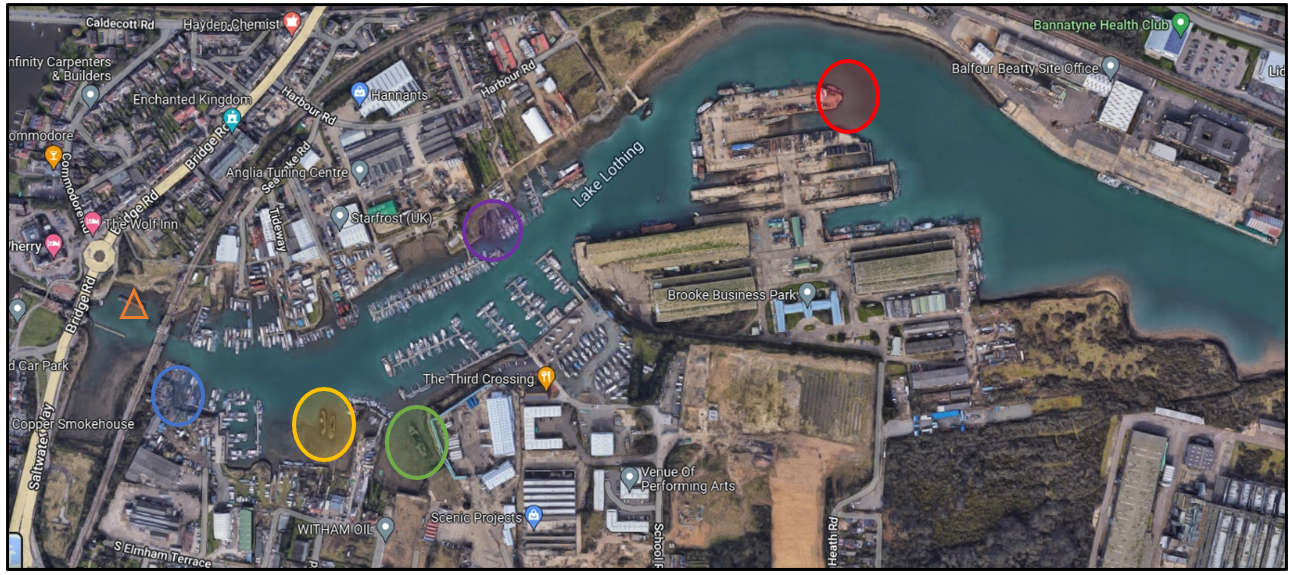
I got up early one cold morning, went down with my inflatable packraft and launched into the lake from one of the derelict slipways. Unfortunately, I had had chosen a day with a very high spring tide so the wrecks were a bit more hidden than I would have liked.
The first ship I came across was the MV Probe (marked with a green circle above), an WW2 Admiralty Type Motor Minesweeper (MMS 1086) built in Lake Lothing between November 1942 and August 1944.
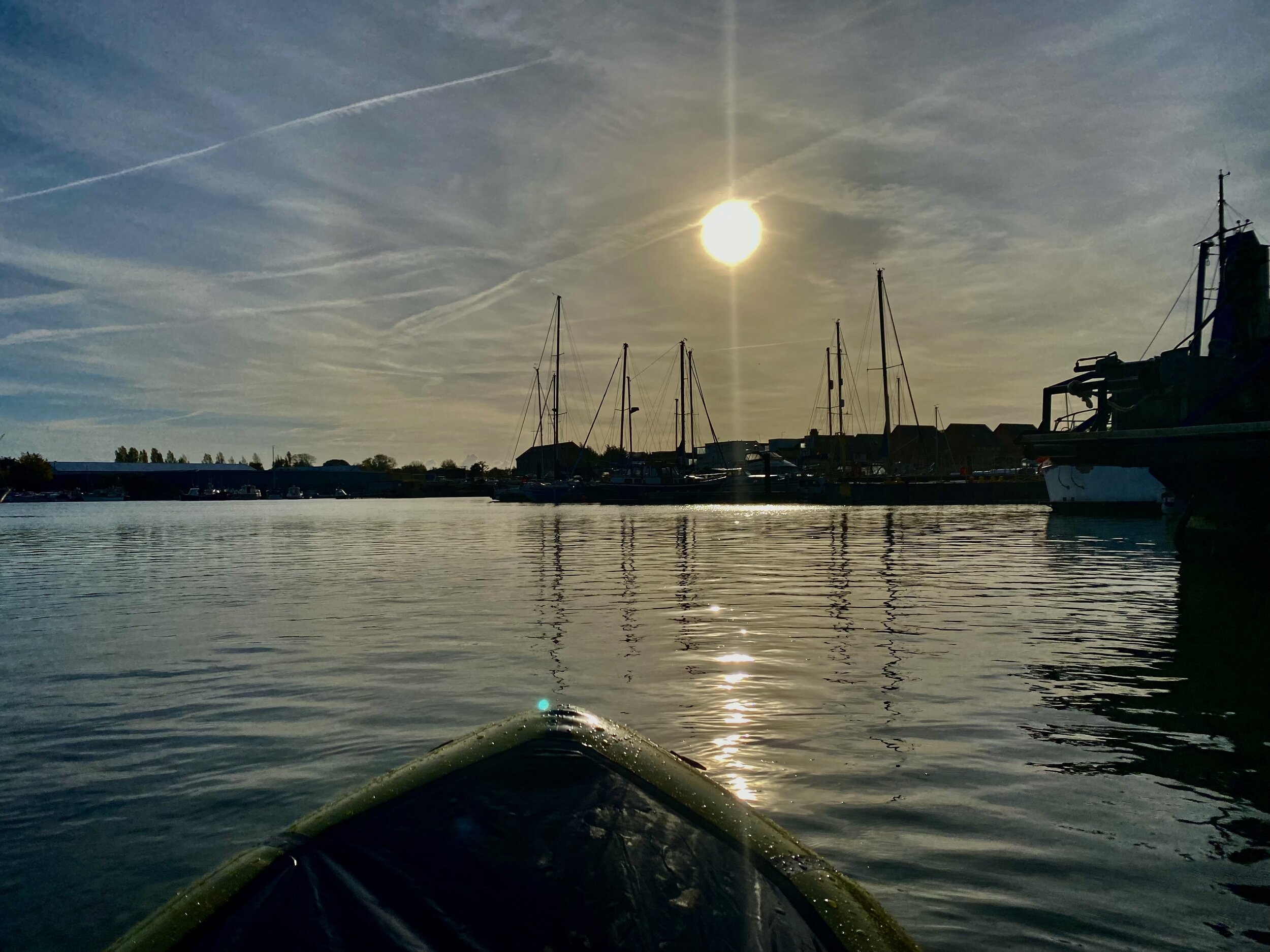
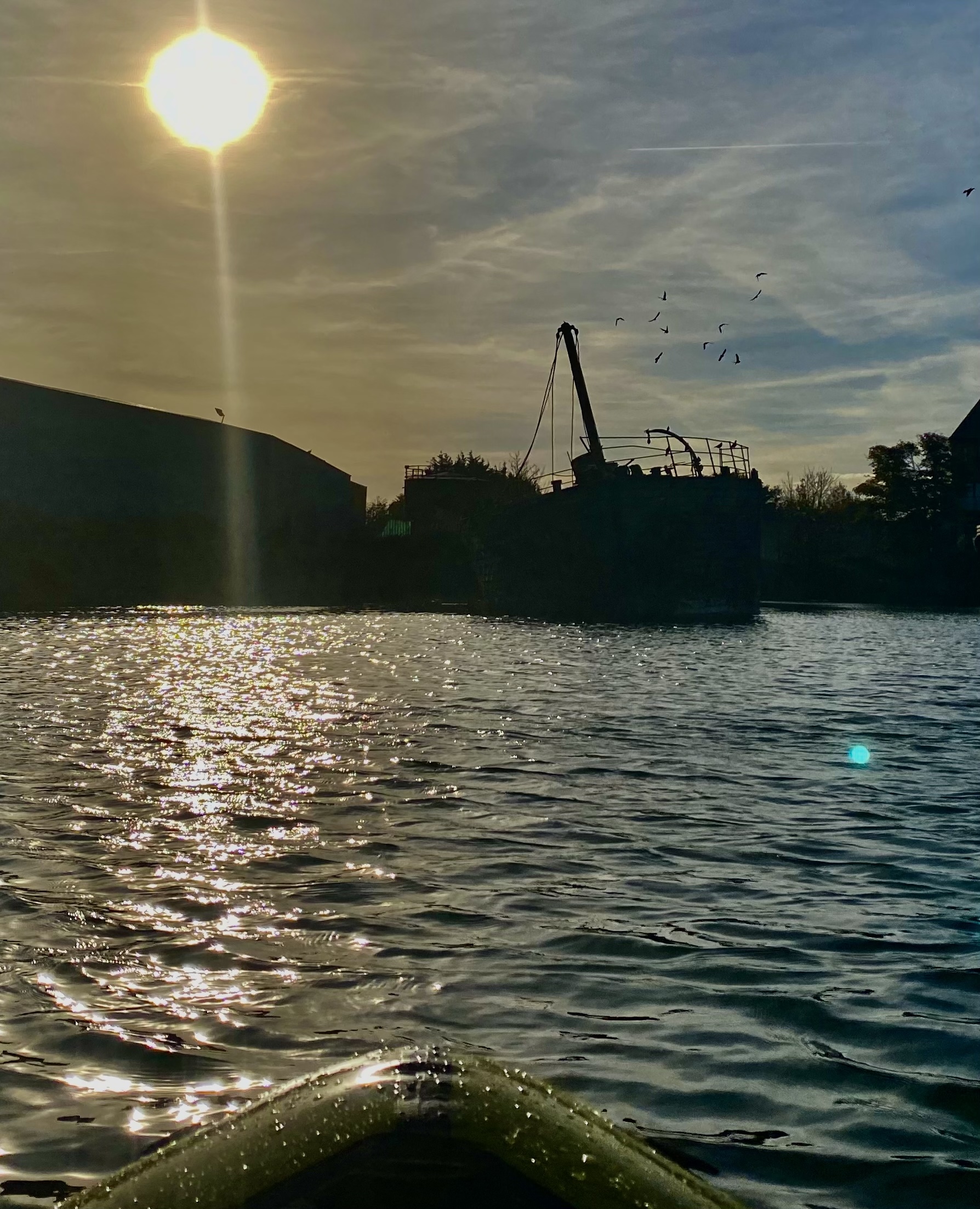
There were 90 of this type of MMS class minesweepers produced, nicknamed Mickey Mouses, they measured 38m long and 8m wide, with a displacement on 360 tonnes. They were made with wooden hulls so that they would not be vulnerable to magnetic mines used extensively by the German Navy and were fitted out with 4x20mm guns. Below is a picture of this vessel in all its glory in all its glory.
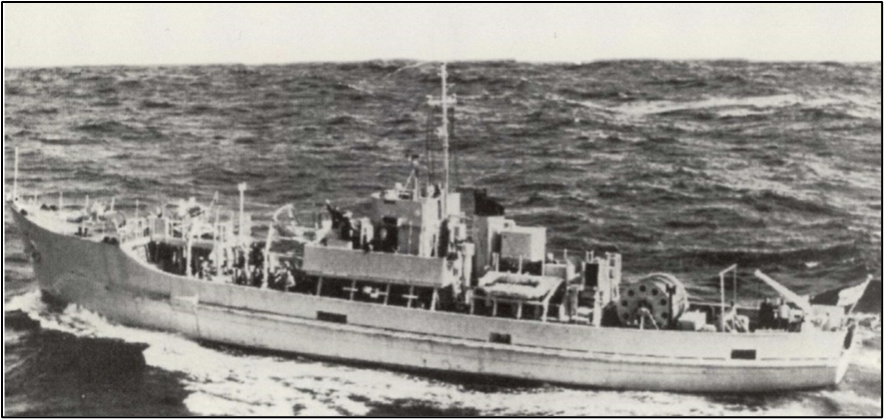
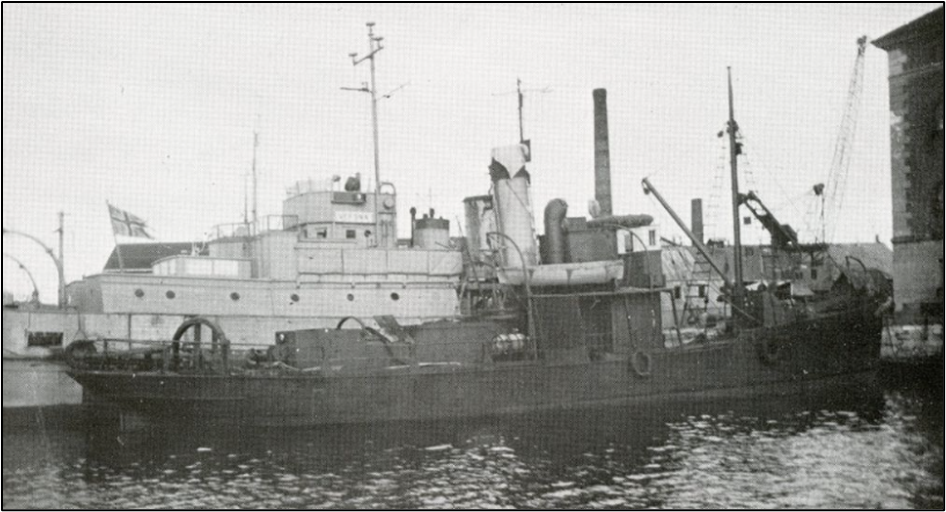
This vessel (MMS 1086) was transferred in 1944 to the Norwegian Navy and named Vefsna. After the war, she was sold to the Norwegian Government and outfitted as a hospital ship. In 1961 she was sold into private ownership and converted into a survey vessel for undertaking seismic surveys on the sea floor (called RV Probe) and operated out of Lowestoft searching for North Sea Oil and Gas reserves. Above right is a picture taken in the 1940s of her fitted out as a hospital ship.
In 1969 she was sold again to a scrapyard in Lowestoft, but the yard went bust before demolition could commence and the hull was left abandoned and unowned. Since then, she has sat there slowly rotting away. Below is the wreck in its current state from the stern first and the bow, with the ships name still visible in both, and then form the side with an inquisitive swan.
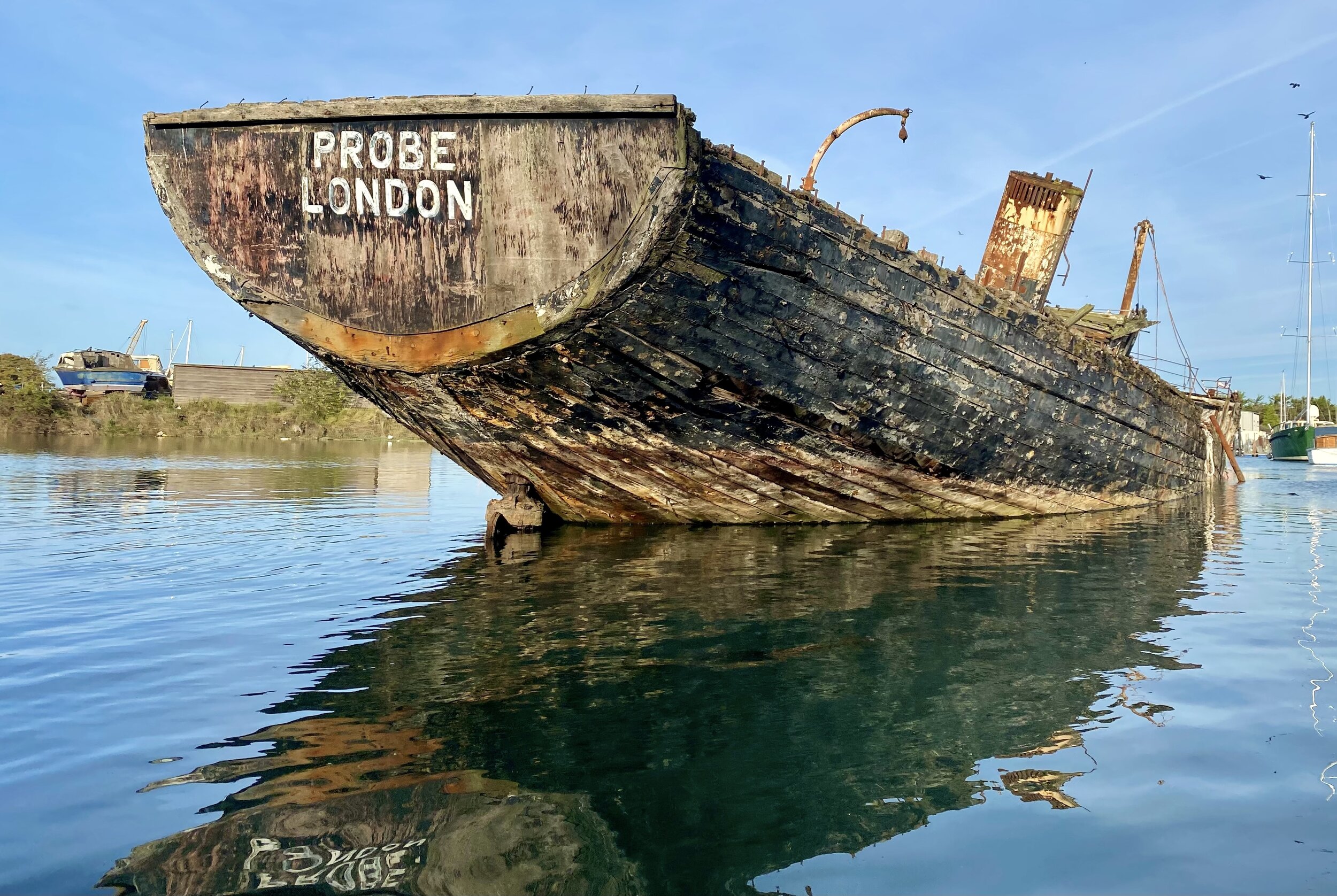
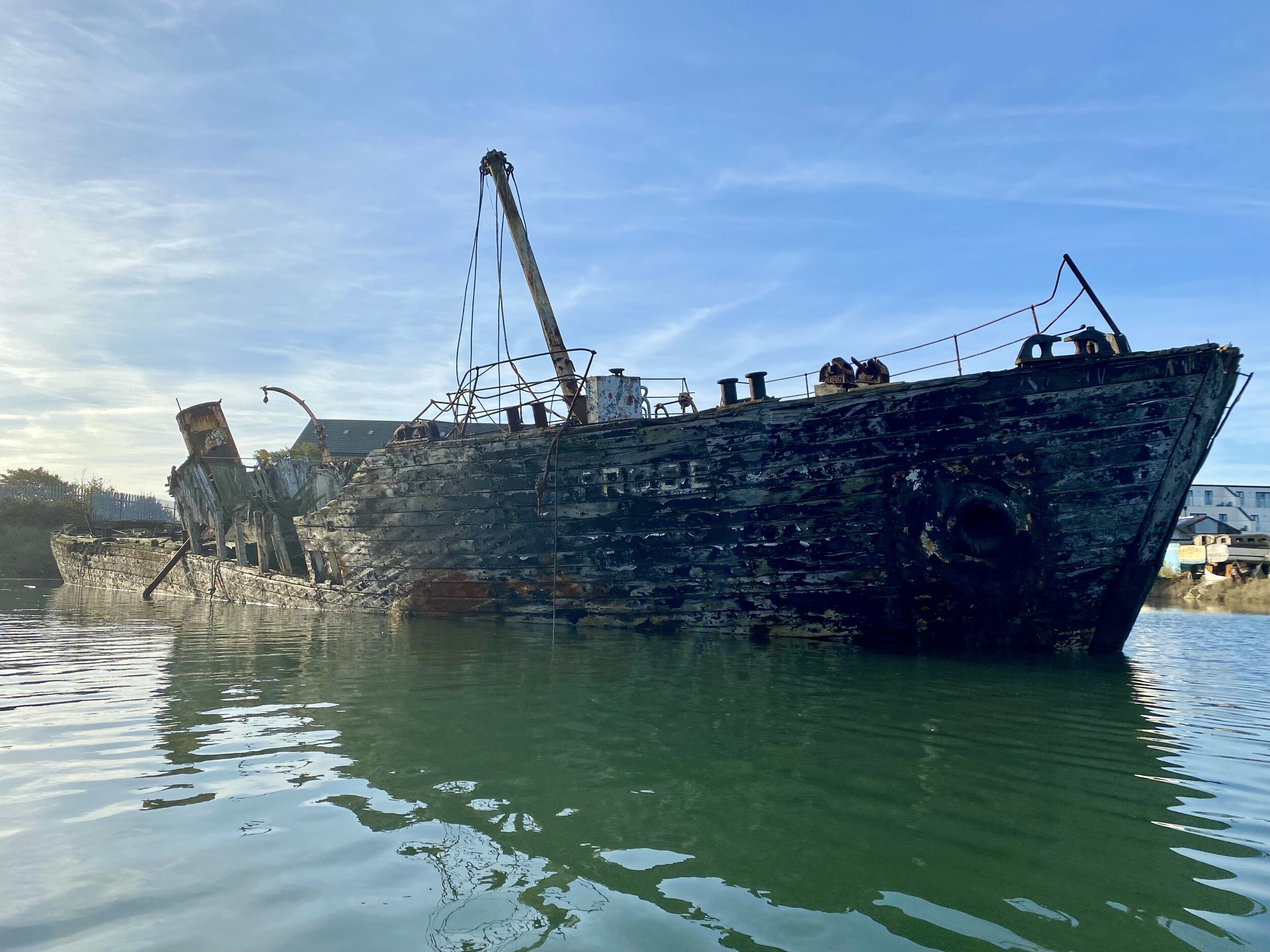
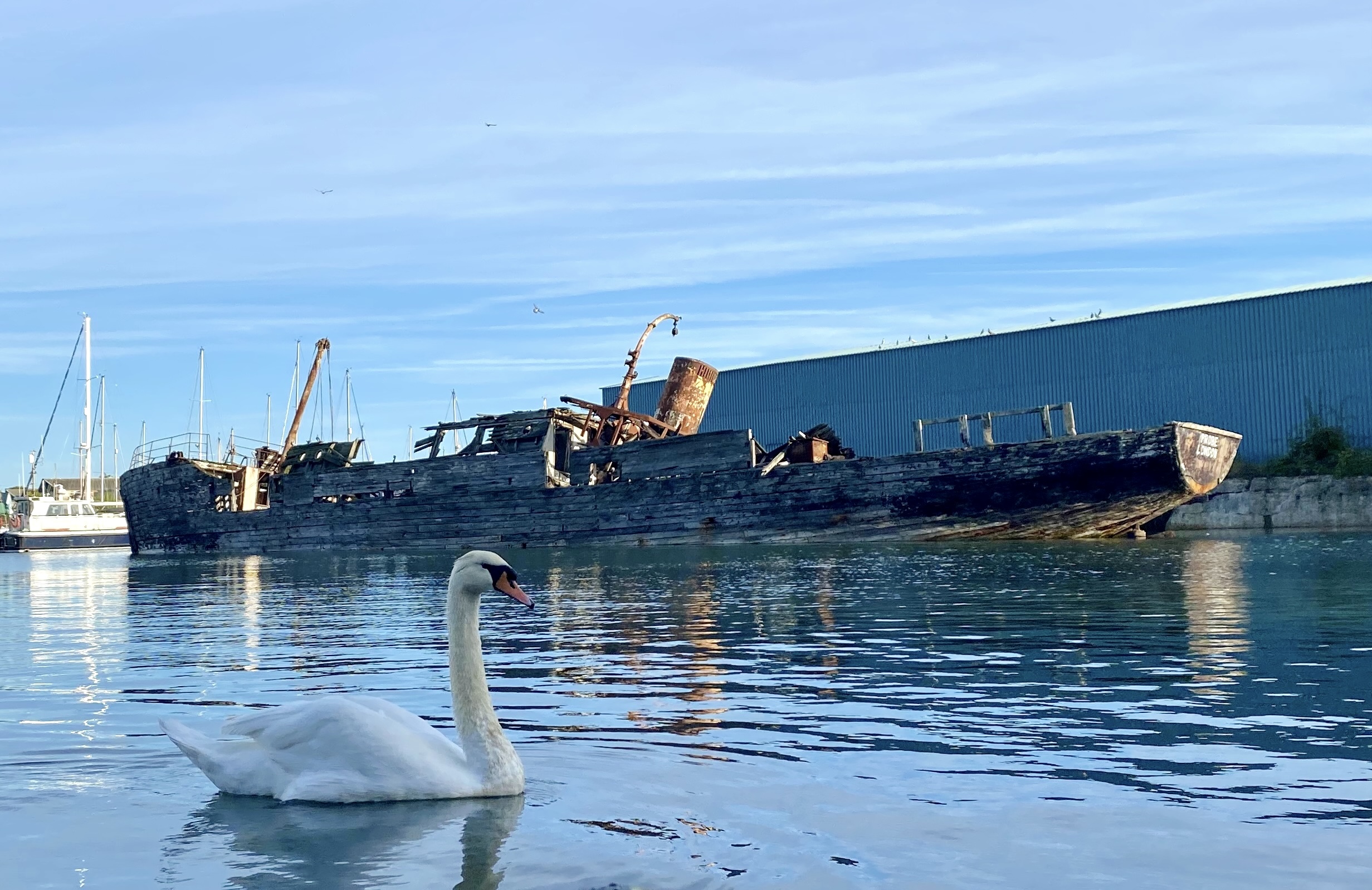
Below shows the state of the ship’s sides, rotting away and full of holes with large rusting nails sticking out.
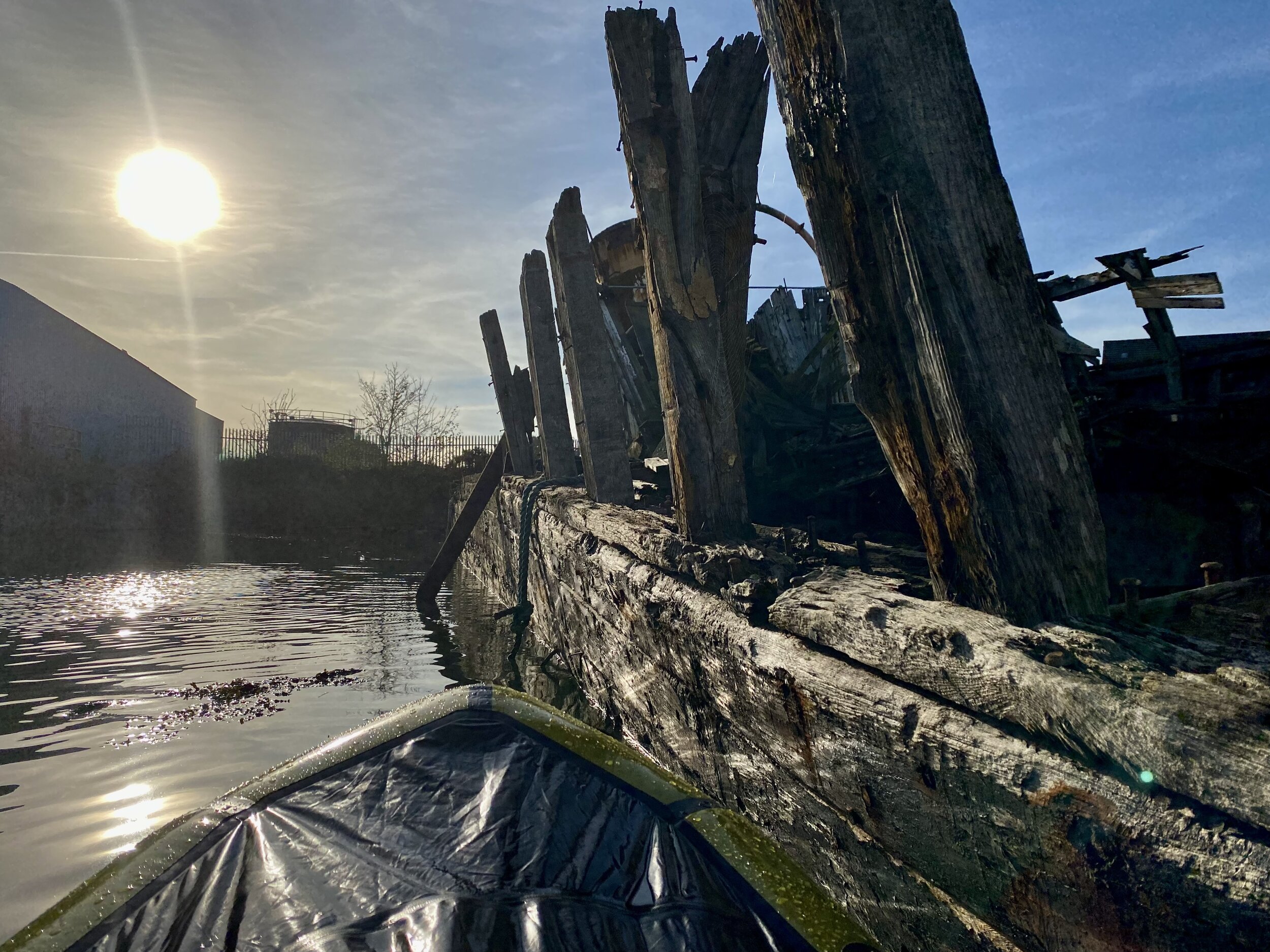
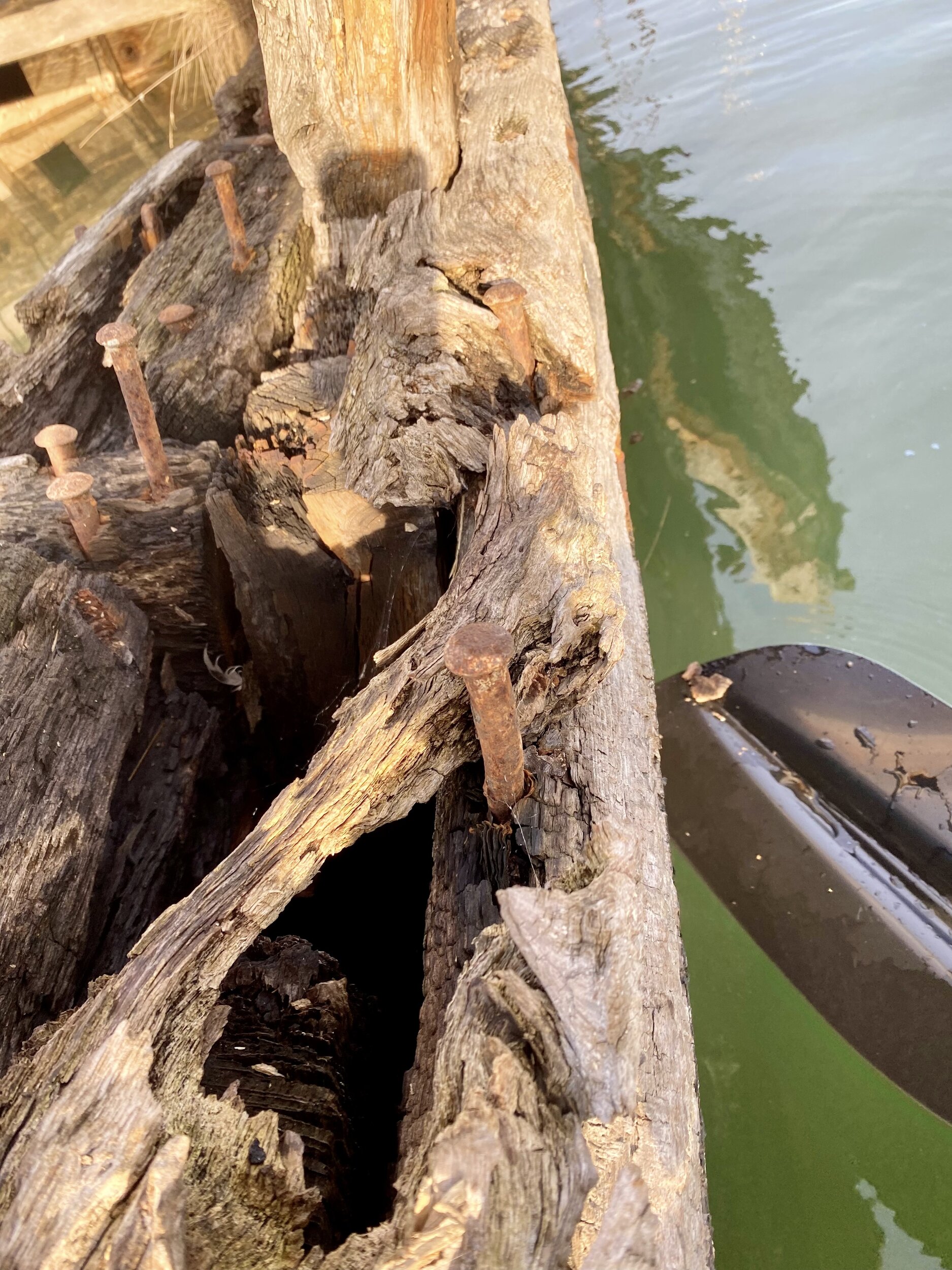
Below shows the insides of the ship – first looking back towards where the wheelhouse once stood, with the decks collapsing, and the second photo looking forwards towards the radio mast and front deck.
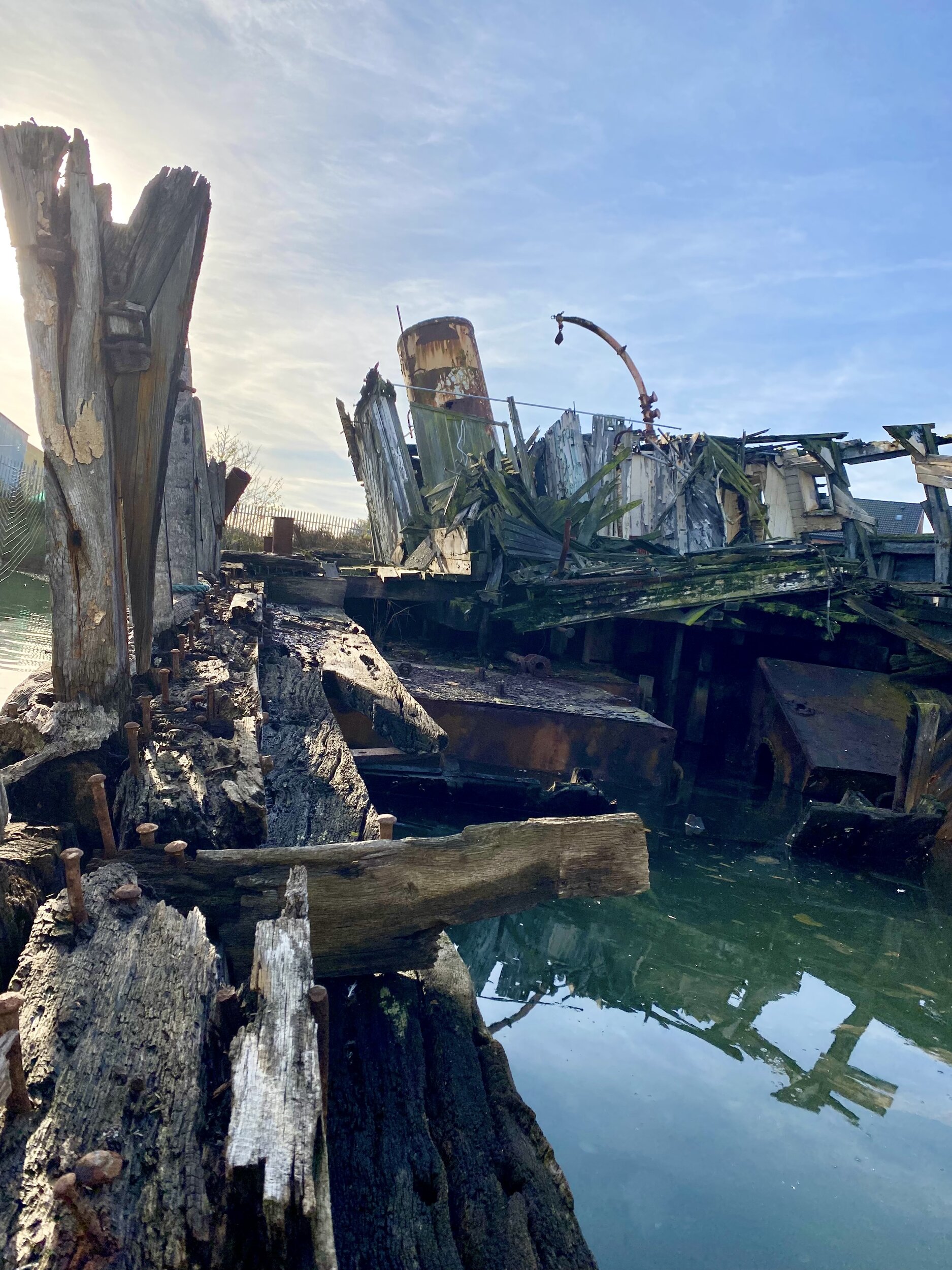
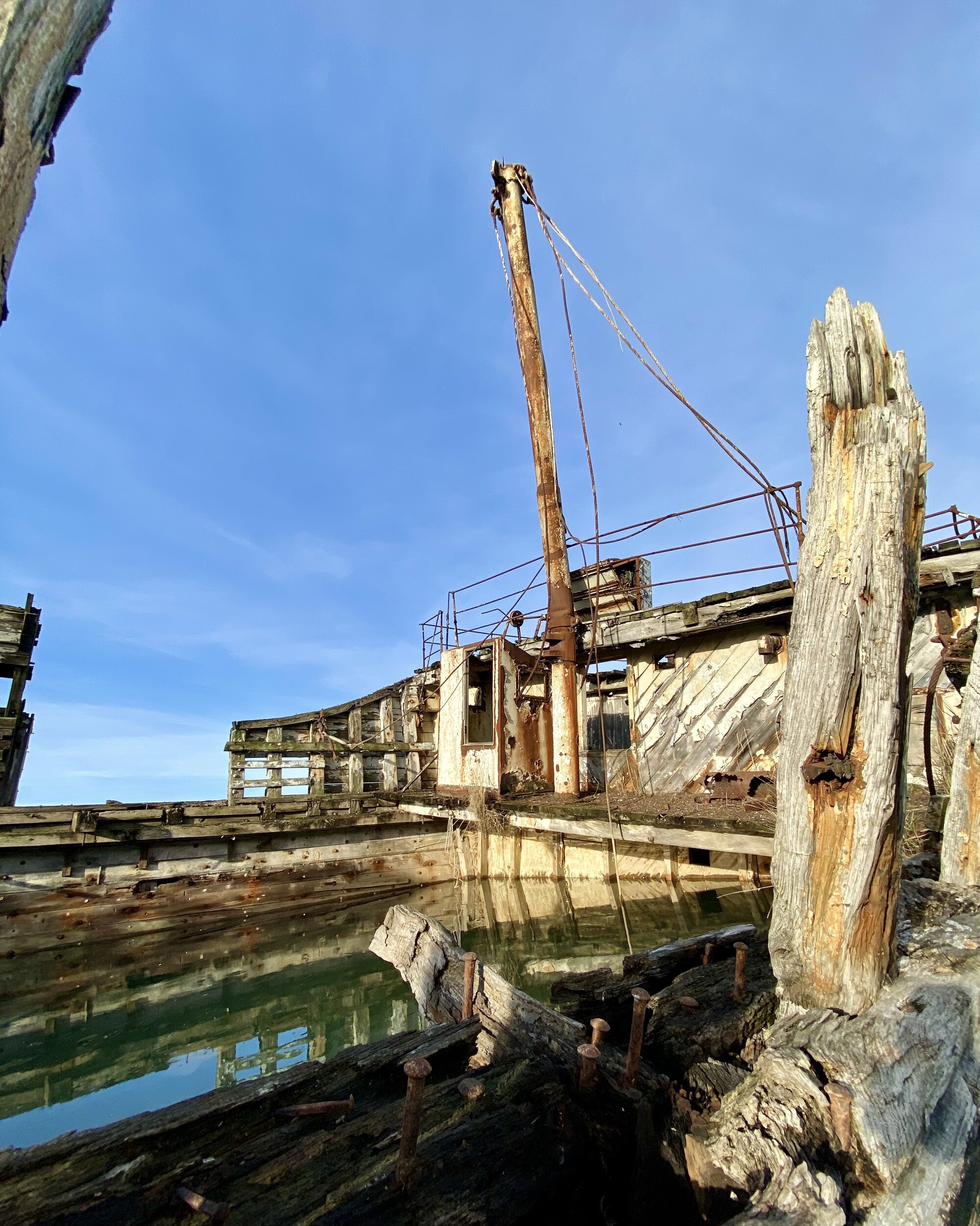
Moving down the hull, being careful not to puncture the kayak on all the nails sticking out, the funnel and cabin can be seen in more detail. Both of these are sinking rapidly into the hull
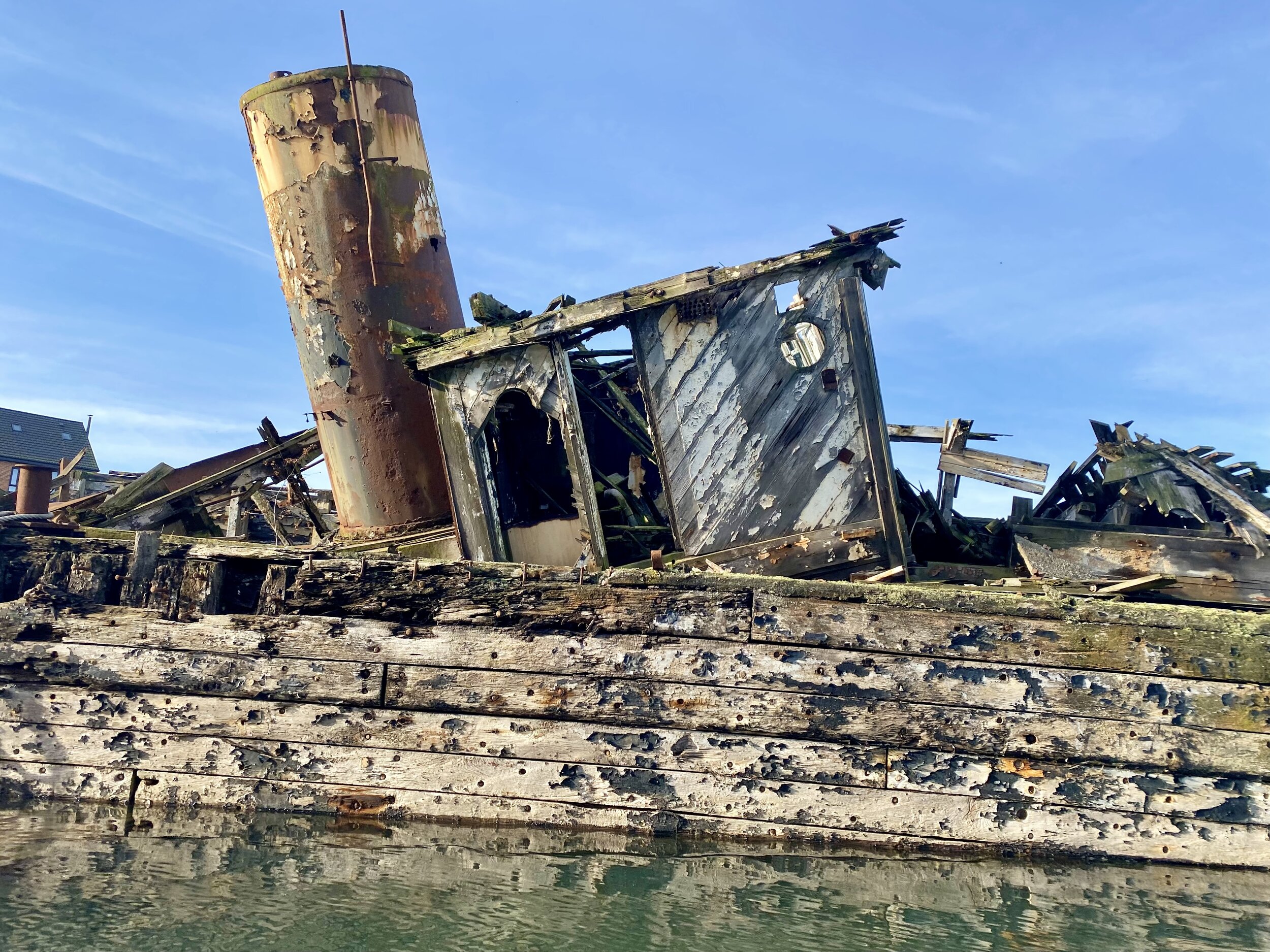
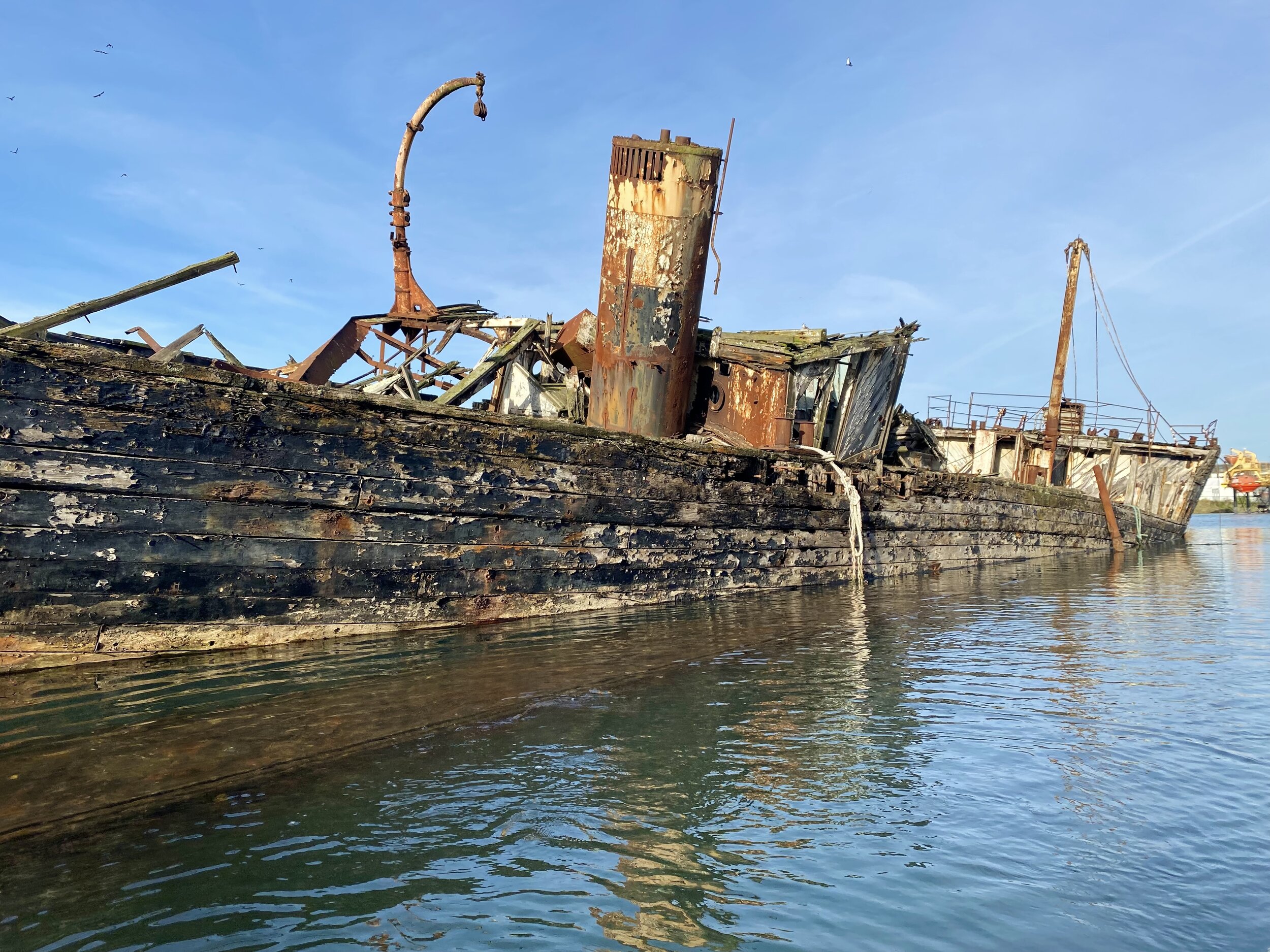
The next wreck I came across was the LT326 Yellowtail, a 119-ton MFV (Motor Fishing Vessel) which was a class 1501 beam trawler built between December 1942 and September 1945 in Cornwall. (MFV 1529)
Originally ordered by the Admiralty, 81 Motor Fishing Vessels (MFVs) in the ‘1501-Class’ were built during World War II. MFVs were small wooden craft, 26m long by 7m wide, built-in large numbers during the war for use as Ship's tenders. They had a crew of 11 men, and standard armament of 1 20mm Anti-Aircraft gun for defence.
After the war, this ship operated out of Lowestoft as a fishing vessel named Maravanne until 1959 where its name was changed to Yellowtail. Whilst moored in Lake Lothing she sank in 1979 between the road and rail bridges (shown by the yellow triangle in the satellite image above). She remained here for a while (see below left prior to sinking and right after).
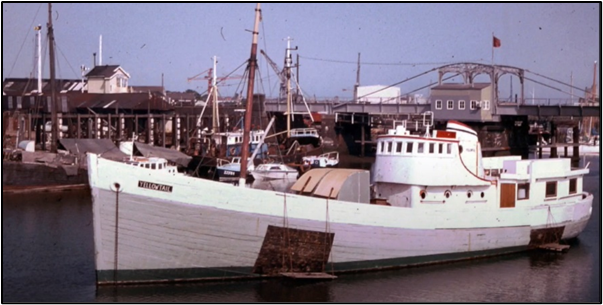
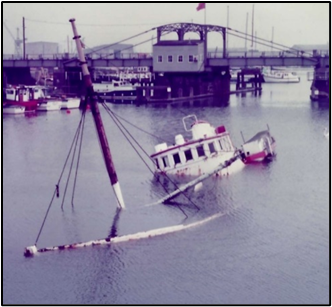
In late 80s she was raised and moved to the other side of the rail bridge where she has remained since. Over the years, the aft cabin, superstructure and deck have slowly collapsed leaving just the wheelhouse section standing proud above the deck. The photos below show the wreck from behind (left) and from floating above the deck (right).
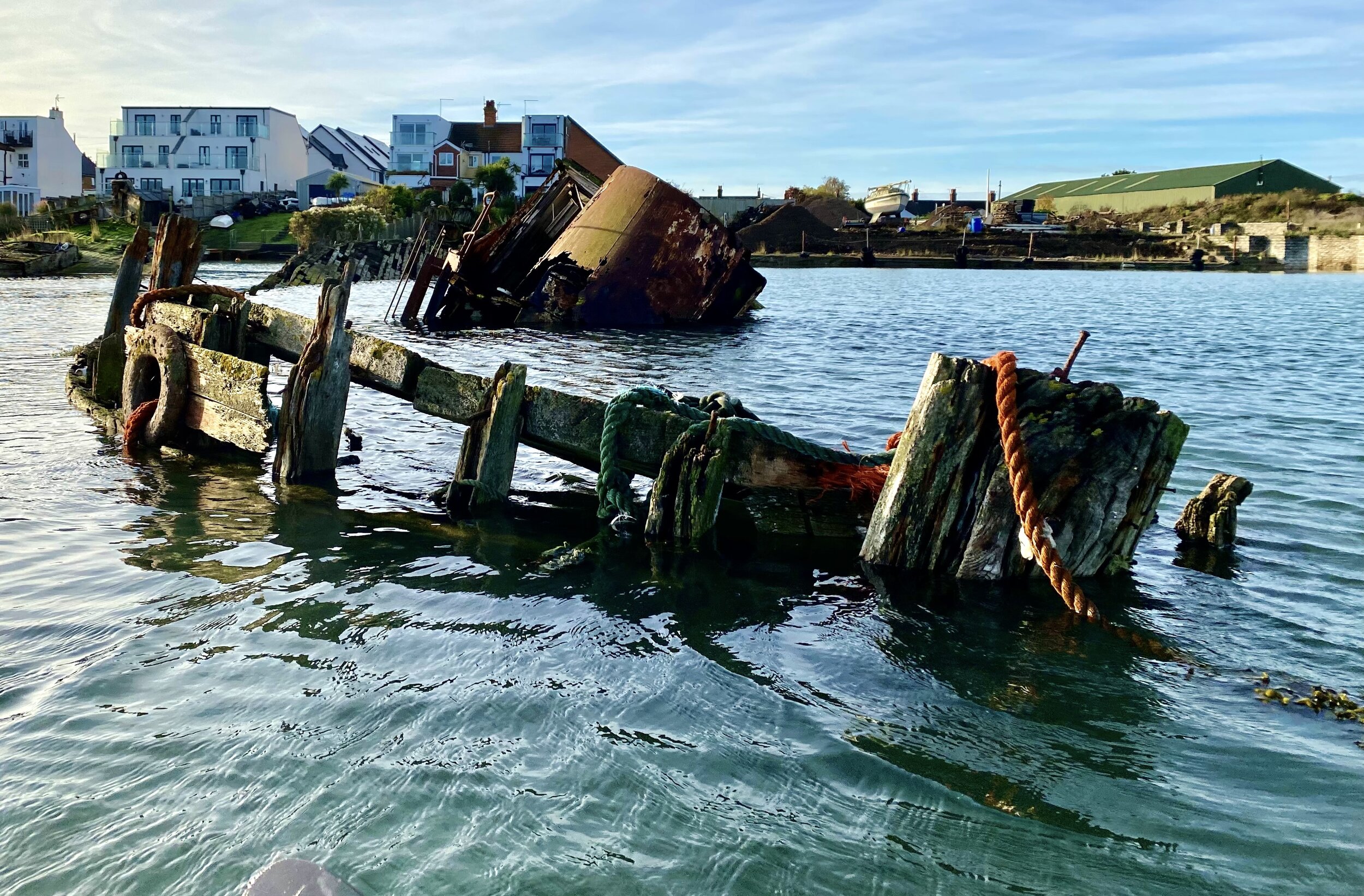
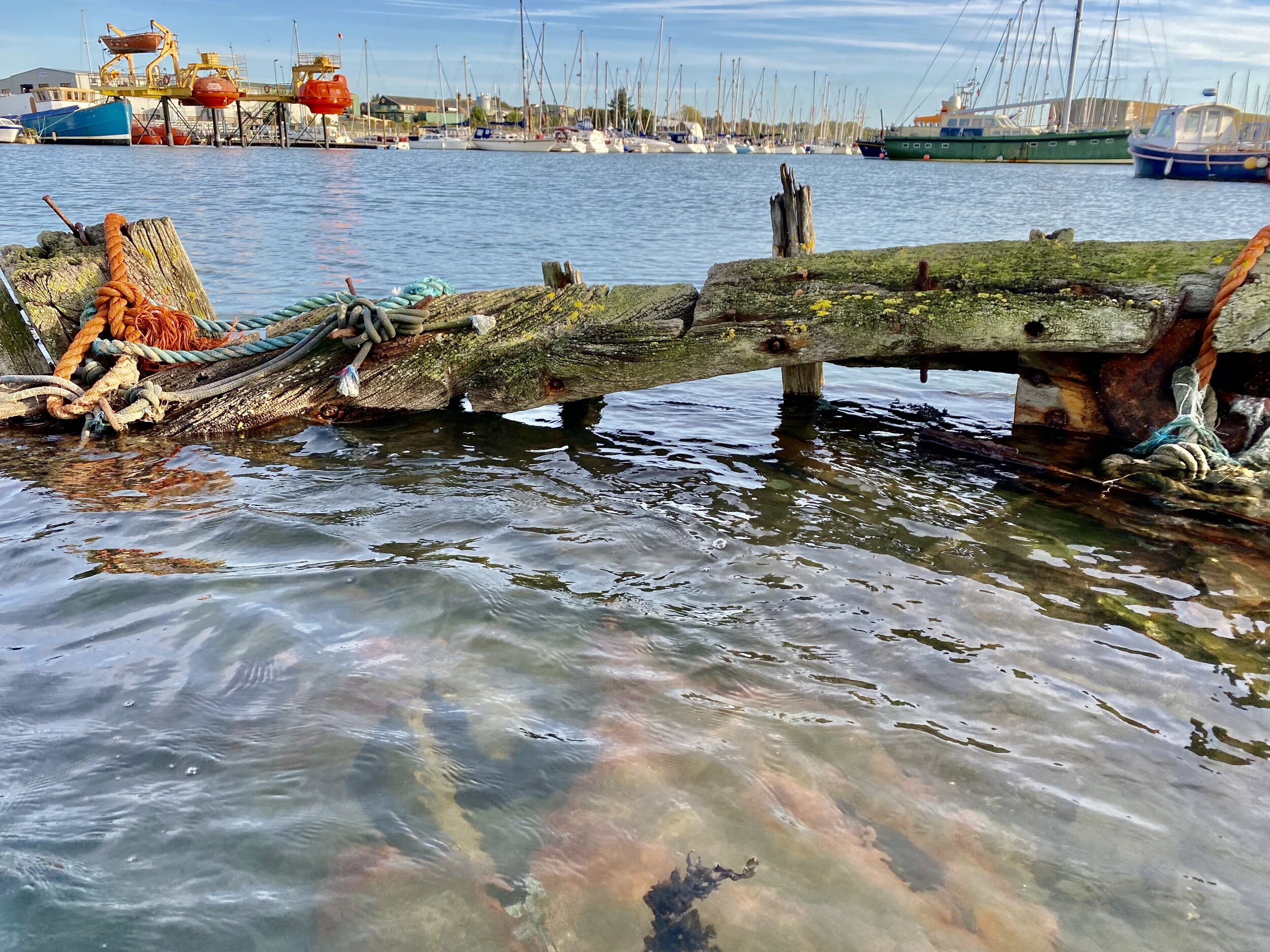
The photos below (left) show the back of the funnel and wheelhouse, floating above the tangled remains of the aft cabin, and below right shows the funnel and wheelhouse with the rising sun coming up behind (making photos very tricky).
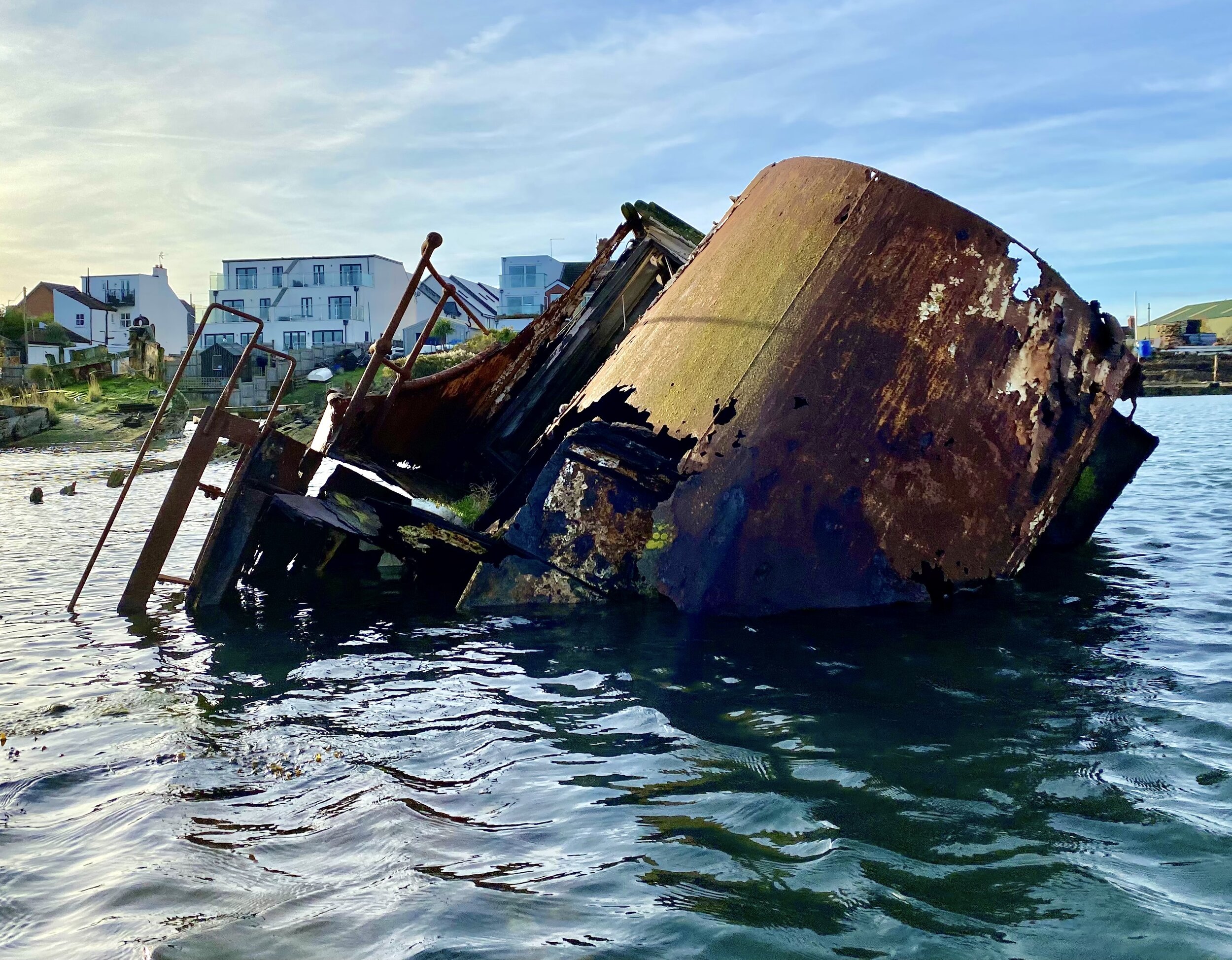
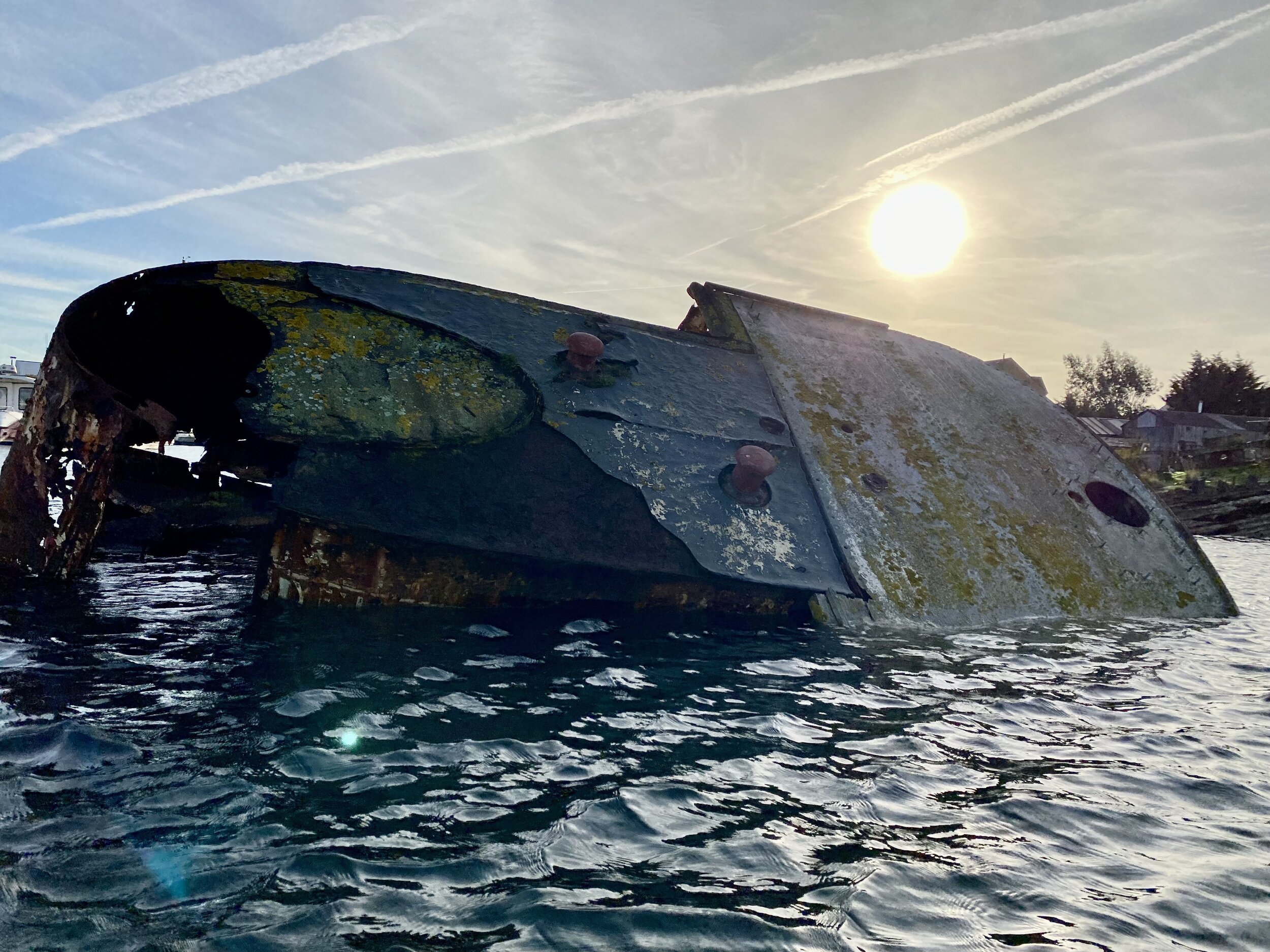
The photo below is a close up of the front of the wheelhouse.
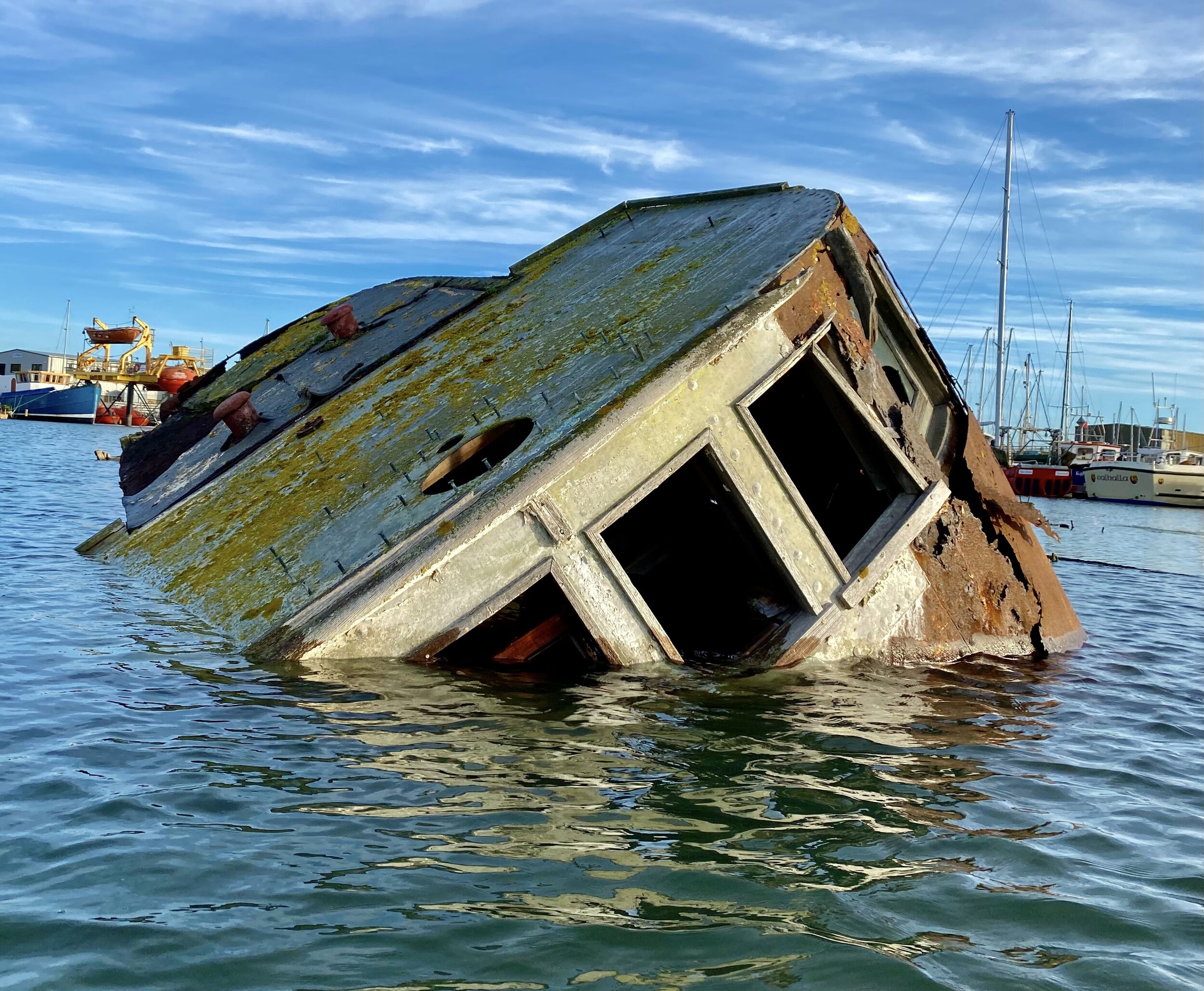
The photos below are taken from just in front of the bow looking down both sides of the wreck.
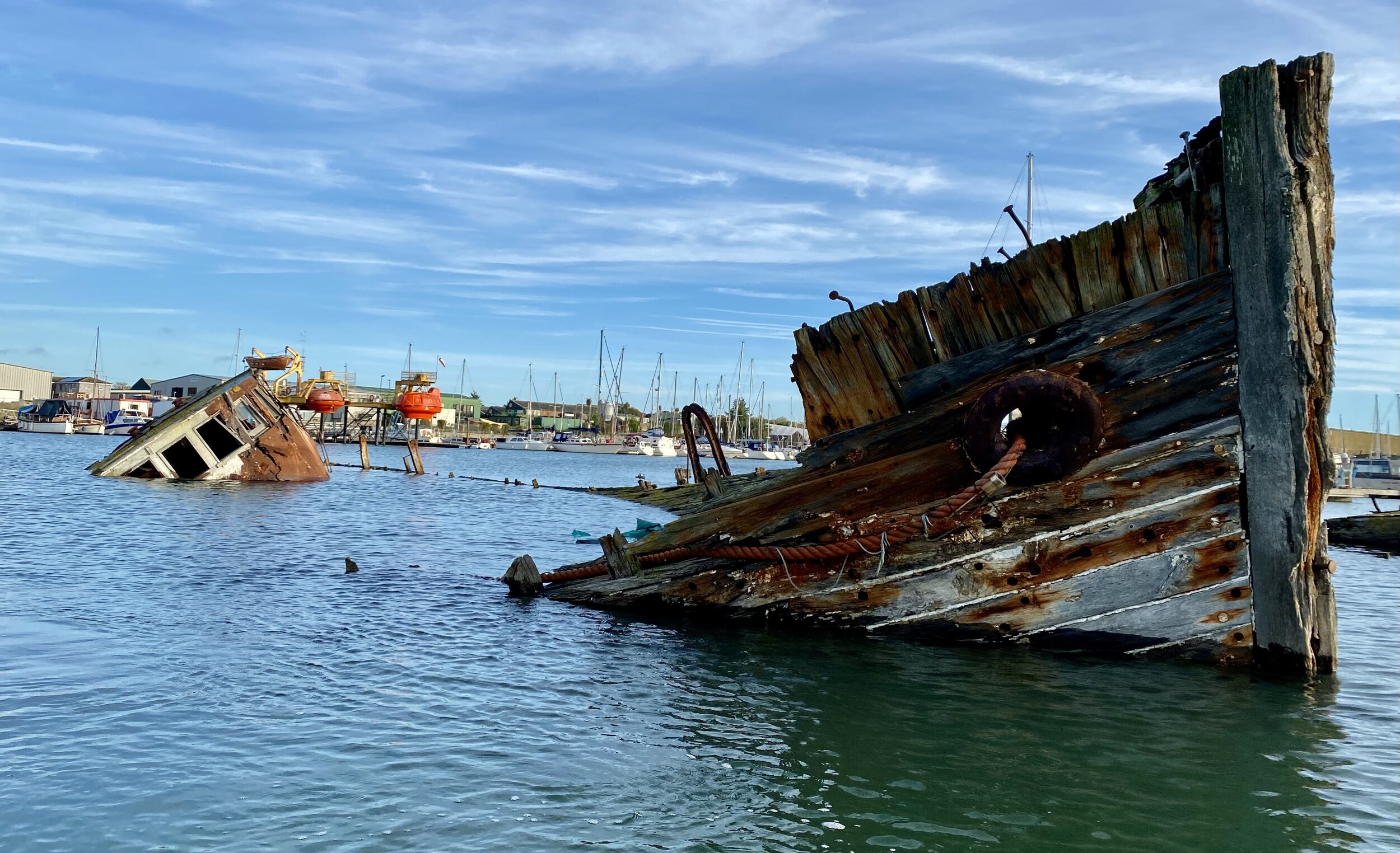
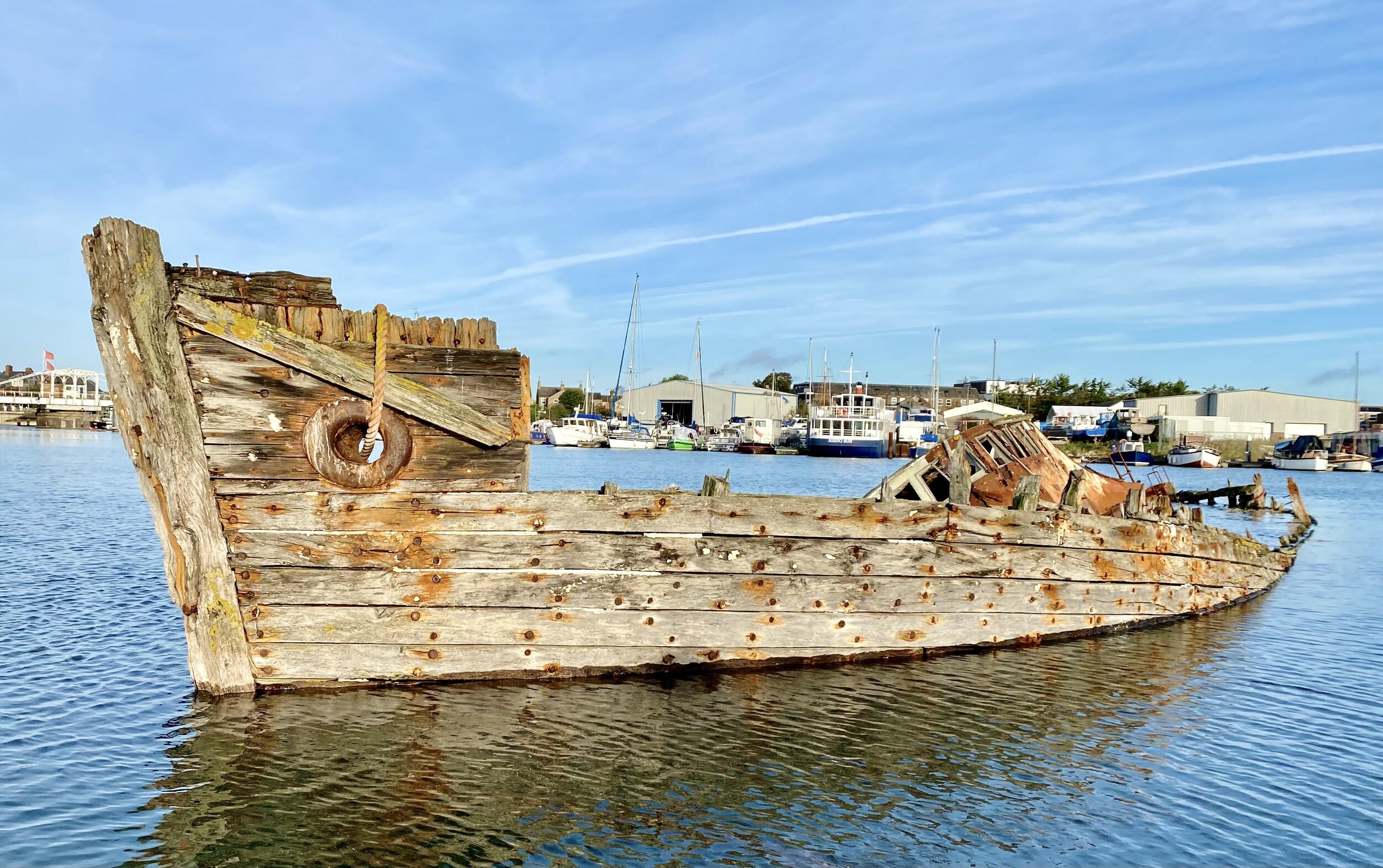
Immediately next to the Yellowtail lies the LT205 RV Platessa, also a 1501 class (MFV 1576) built in 1944 in the same yard as the Probe above but completed around the end of the war, never seeing service. After the war she was operated by the Ministry of Agriculture, Fisheries and Food as a research vessel until 1967 conducting research on the herring and plaice population in the North Sea. Below is a picture of her in action.
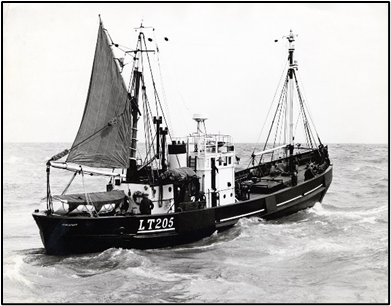
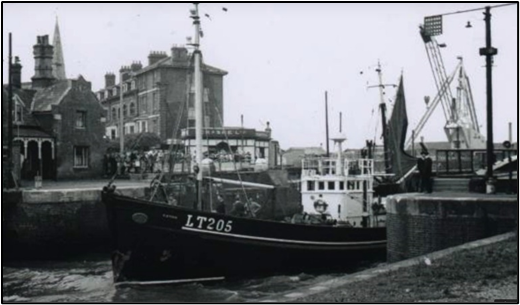
Sold into private ownership in 1968, she sprung a leak near Smith’s Knoll off the north Norfolk coast and was escorted into Lowestoft harbour under escort of the Lifeboat. She sank in the dock shortly after and was eventually hulked out the way in Lake Lothing where she has remained since, next to the Yellowtail, her sister ship.
In the picture below left, the bow can be seen still sticking above the water, still with mooring ropes attached. The wreck of the Yellowtail can be seen to the left. In the bottom right photo I am floating on the main deck about where the cabin would have stood. The large hatch into the hold that can be seen is the same one in the black and white phot above on the foredeck, this is where the fish would have been loaded into.
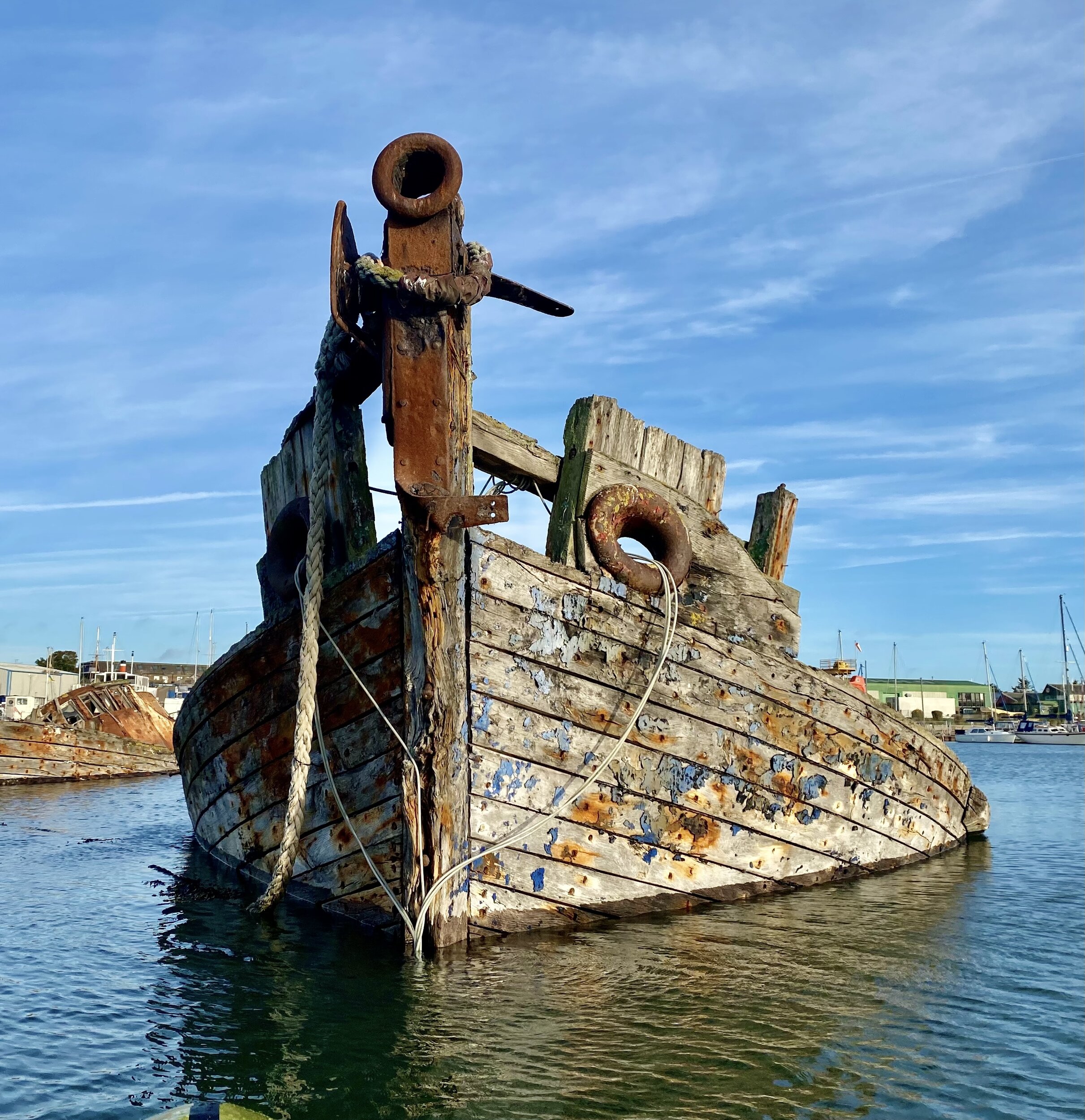
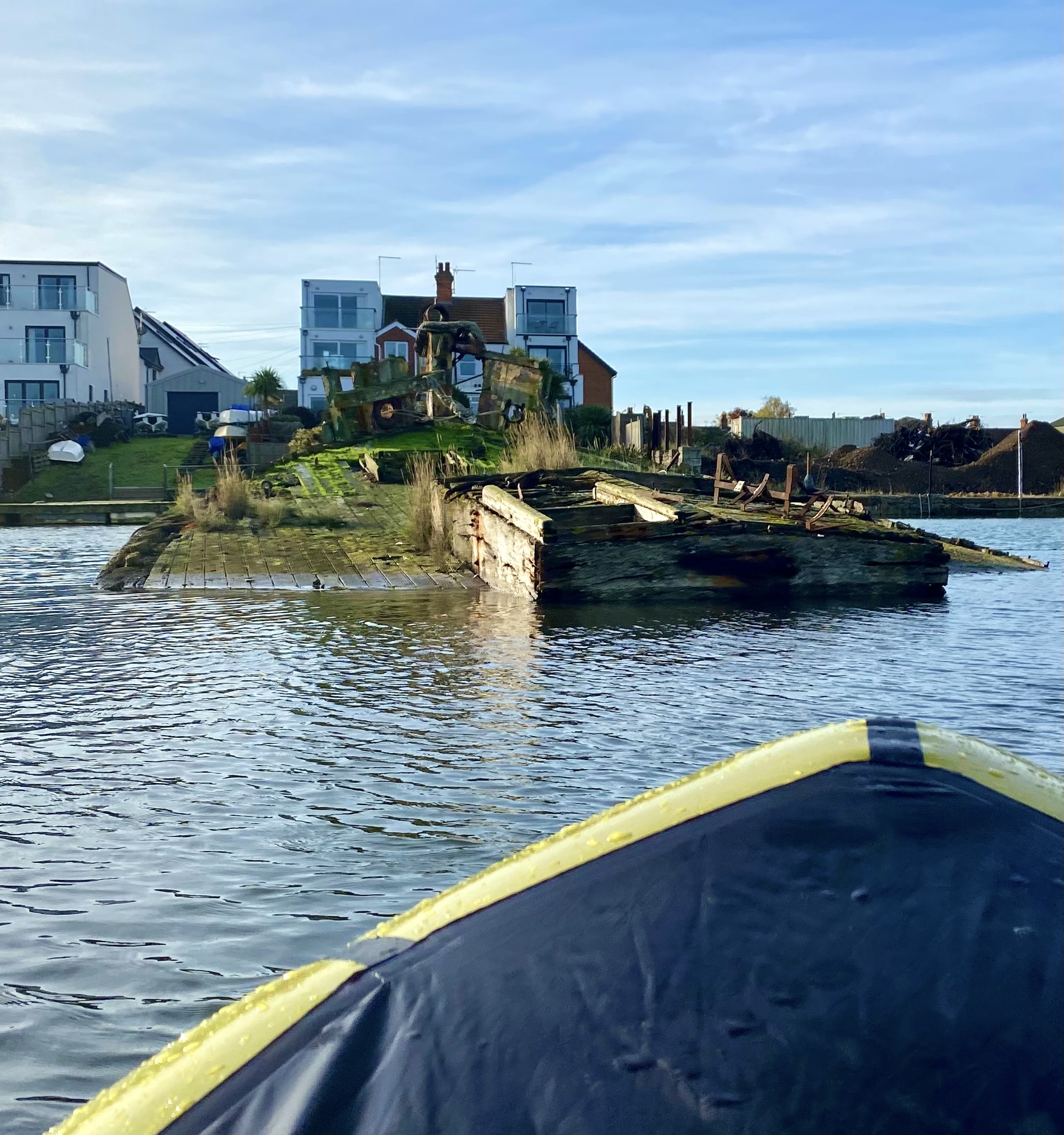
The photo below is taken by the main deck hatch, at low tide the full deck is visible but at high tide (when it isdeep enough to paddle to) only a small amount is visible.
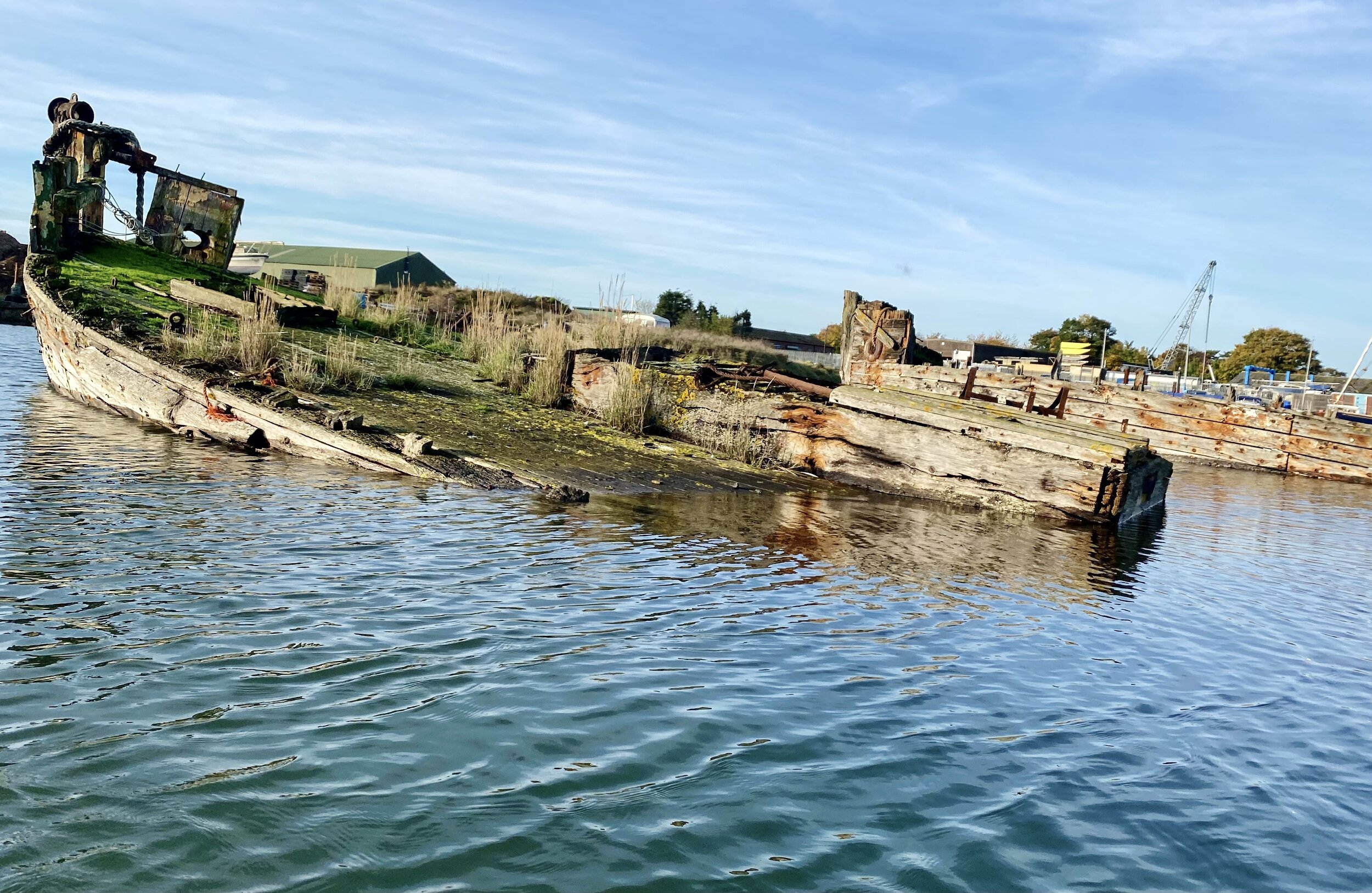
On the opposite side of the lake (see the purple circle above) lies the Eadwine (YH228) which was built in Great Yarmouth in 1914 as a steam drifter. During WW1 she was outfitted with a 6lb gun and served as an armed drifter for the duration of the war under the pennant FL11682. The picture below shows the Eadwine with a canon mounted on the foredeck (I don’t know if this is WW1 or WW2).
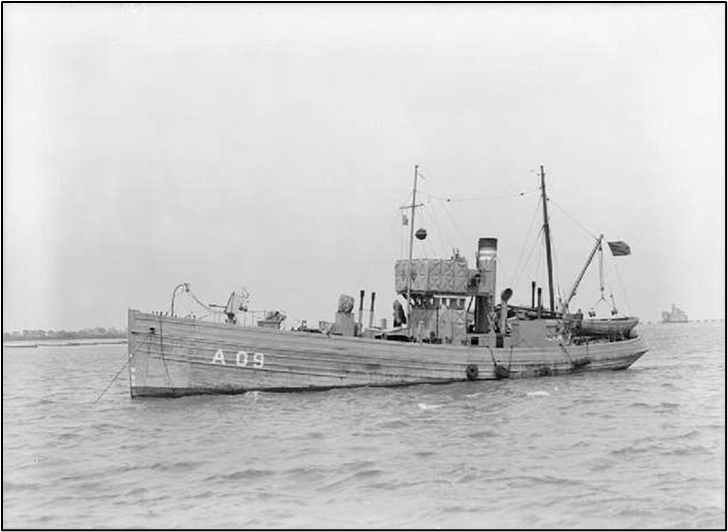
Between the wars she returned to herring fishing out of Great Yarmouth and during WW2 was again called into service (under the Penant FY1892), being outfitted with a 3lb gun and used for patrolling purposes throughout the war.
Interestingly, the Association of Dunkirk Little Ships lists the Eadwine as one for the little ships used during Operation Dynamo, the evacuation of Dunkirk.
After WW2 the Eadwine reverted to operating as a herring drifter (designated YH228) until the circa 1962 when it was sold to a breakers yard. Now only the skeletal remains of the bow, hull and the 26-horsepower steam engine are still visible above the water, as shown below at both low tide (below left) from the shore and at high tide from the water (below right). In the left phto, the stern and the engine can just be seen sticking up out of the mud.
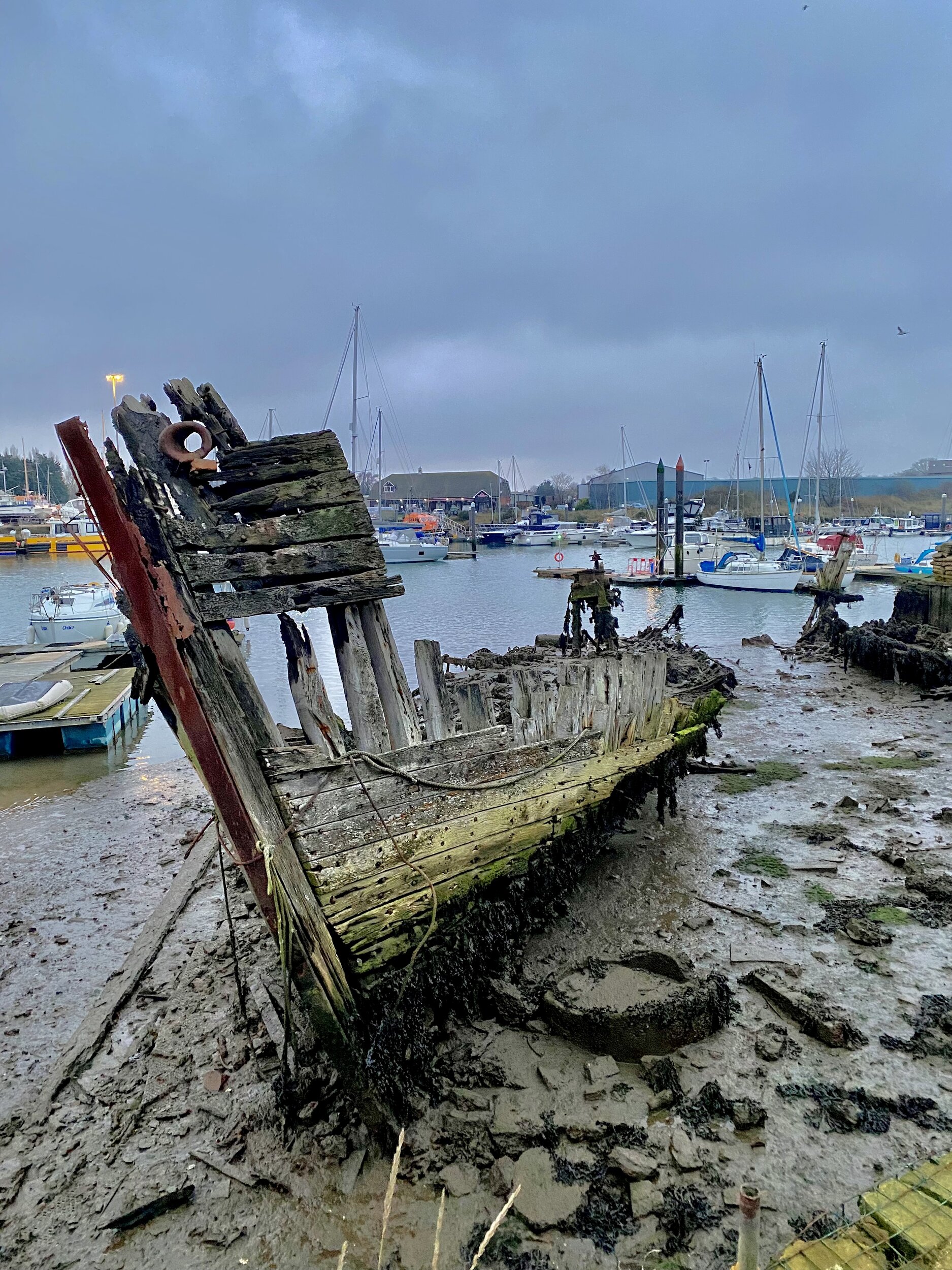
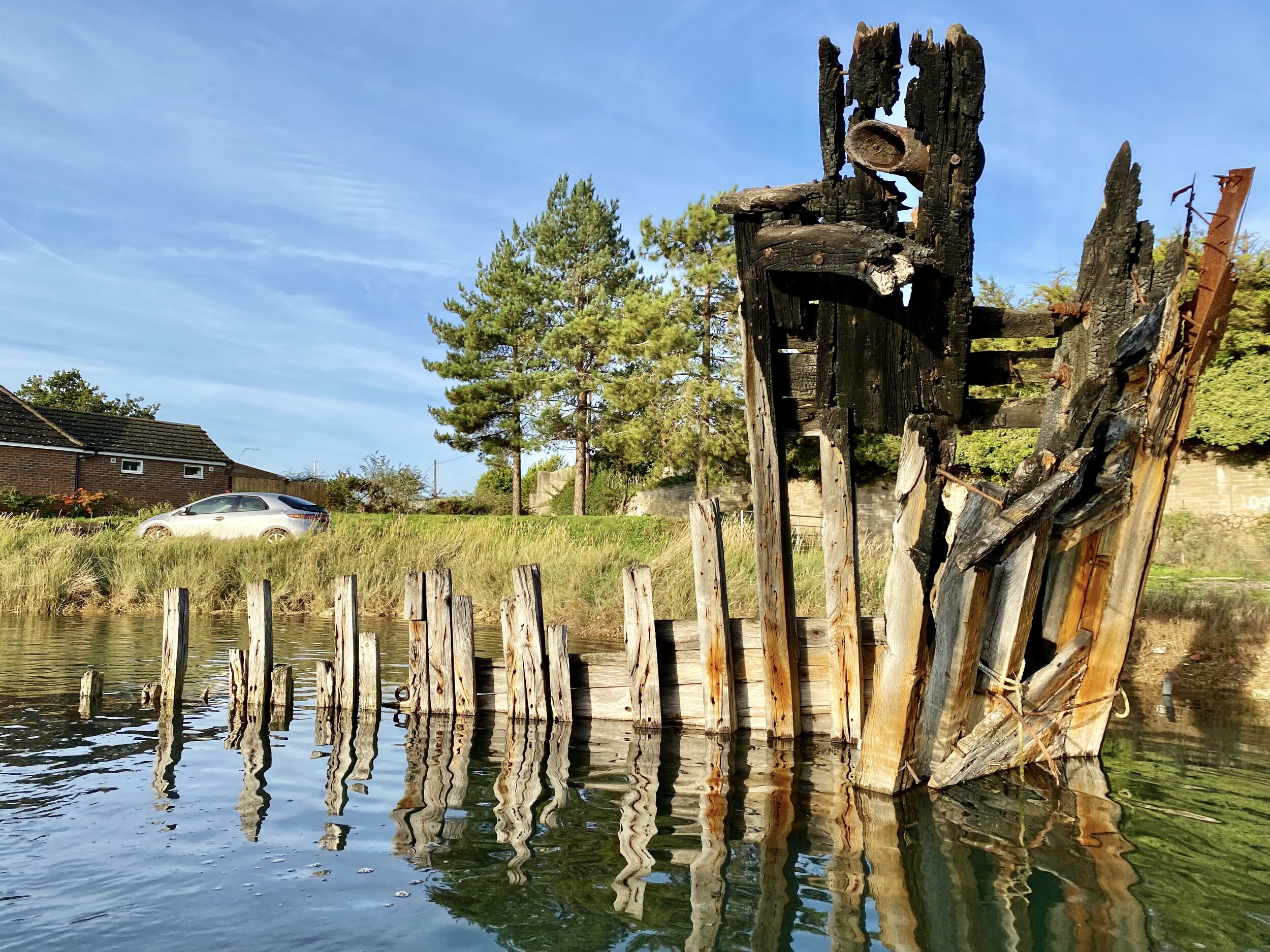
Below is the remains of the 26 horsepower (yes, only 26 hp!!) steam engine. In the left photo the bow can be seen in the backgorund.
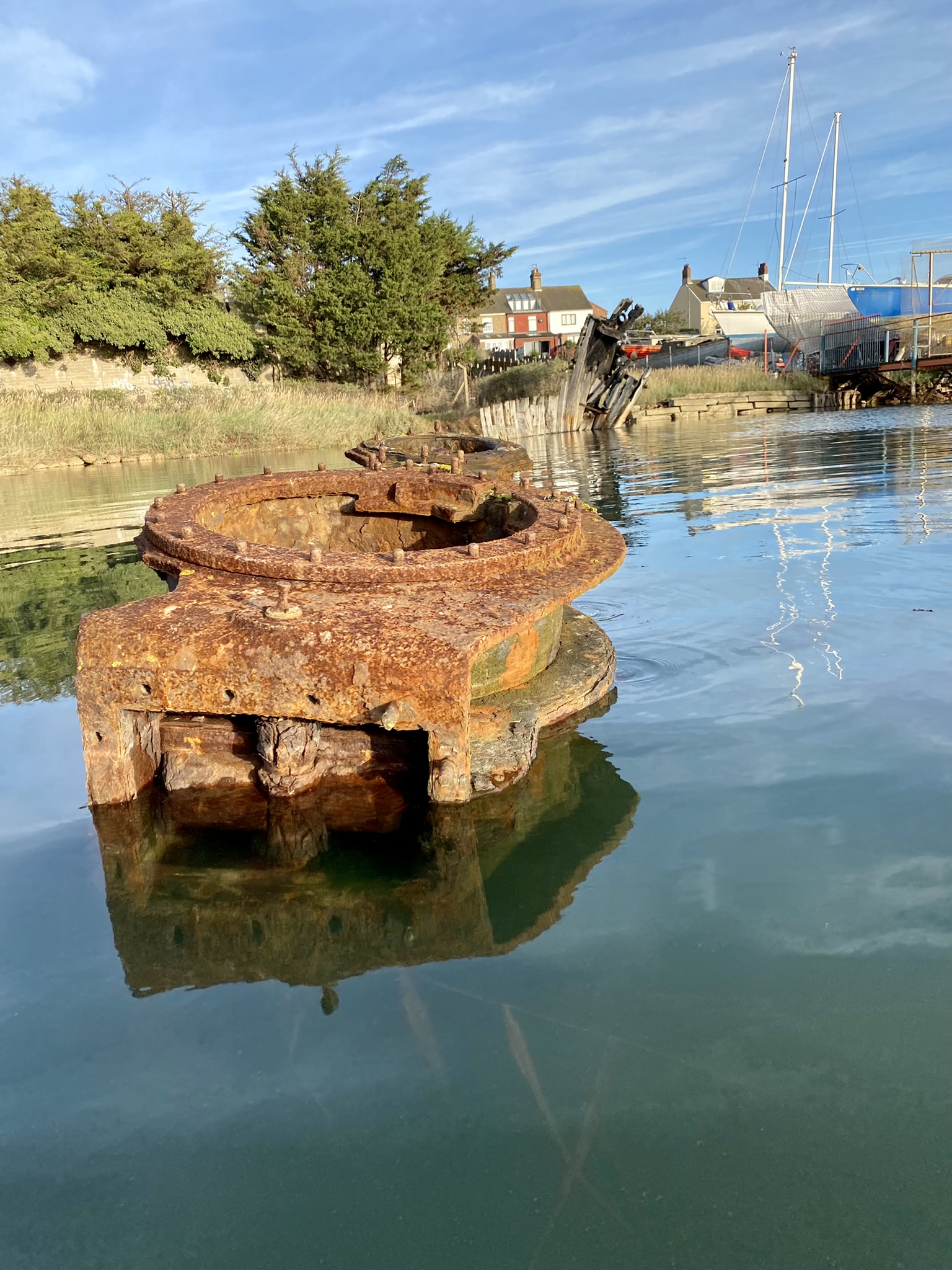
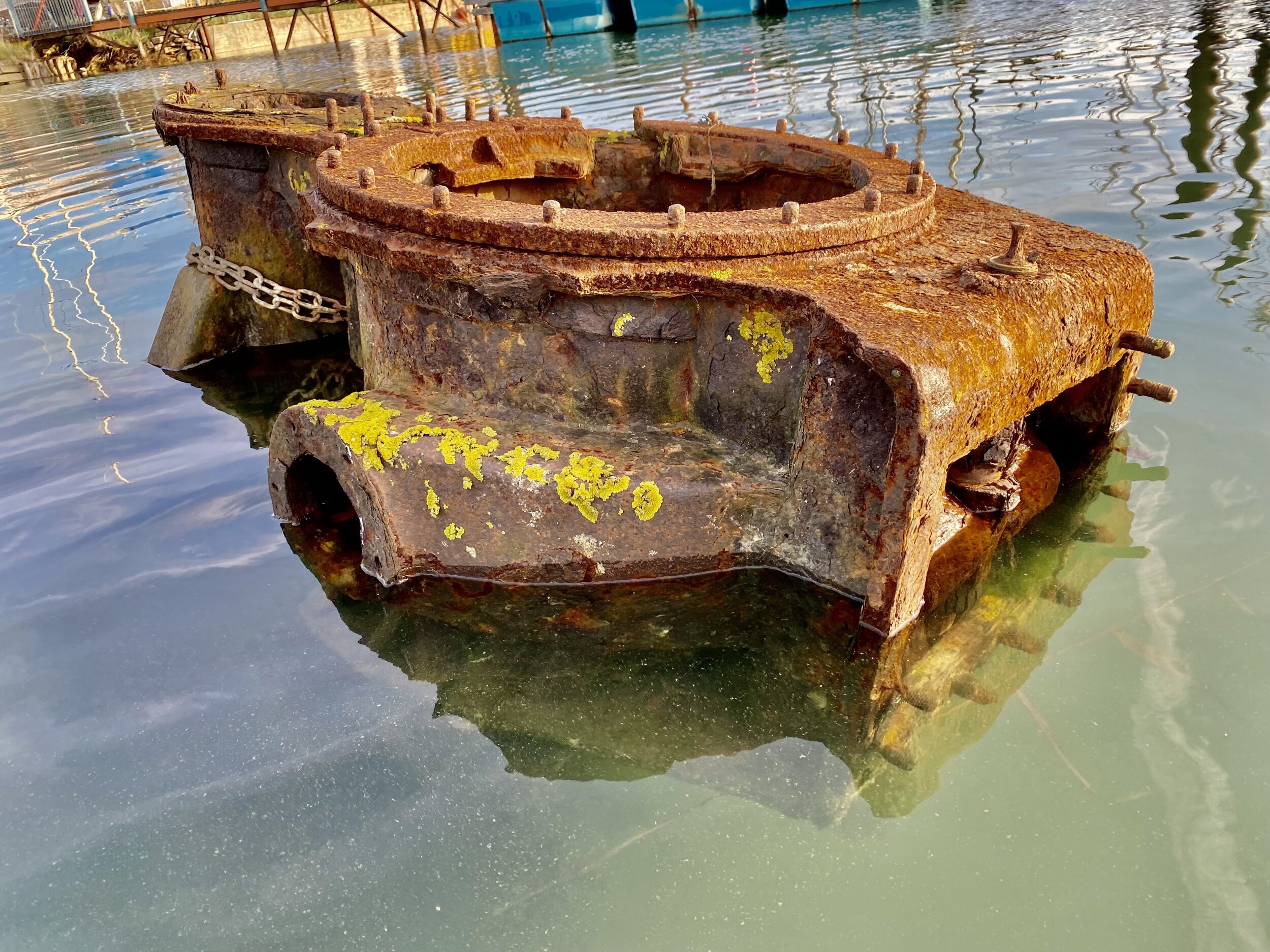
Whilst paddling around I also noticed a few other boats or barges that had suck (e.g. shown by the blue circle in the satellite view above and photos below). At one point I felt the kayak hit something solid, looked down and could see the vague outline of a bow lurking sinisterly beneath me.
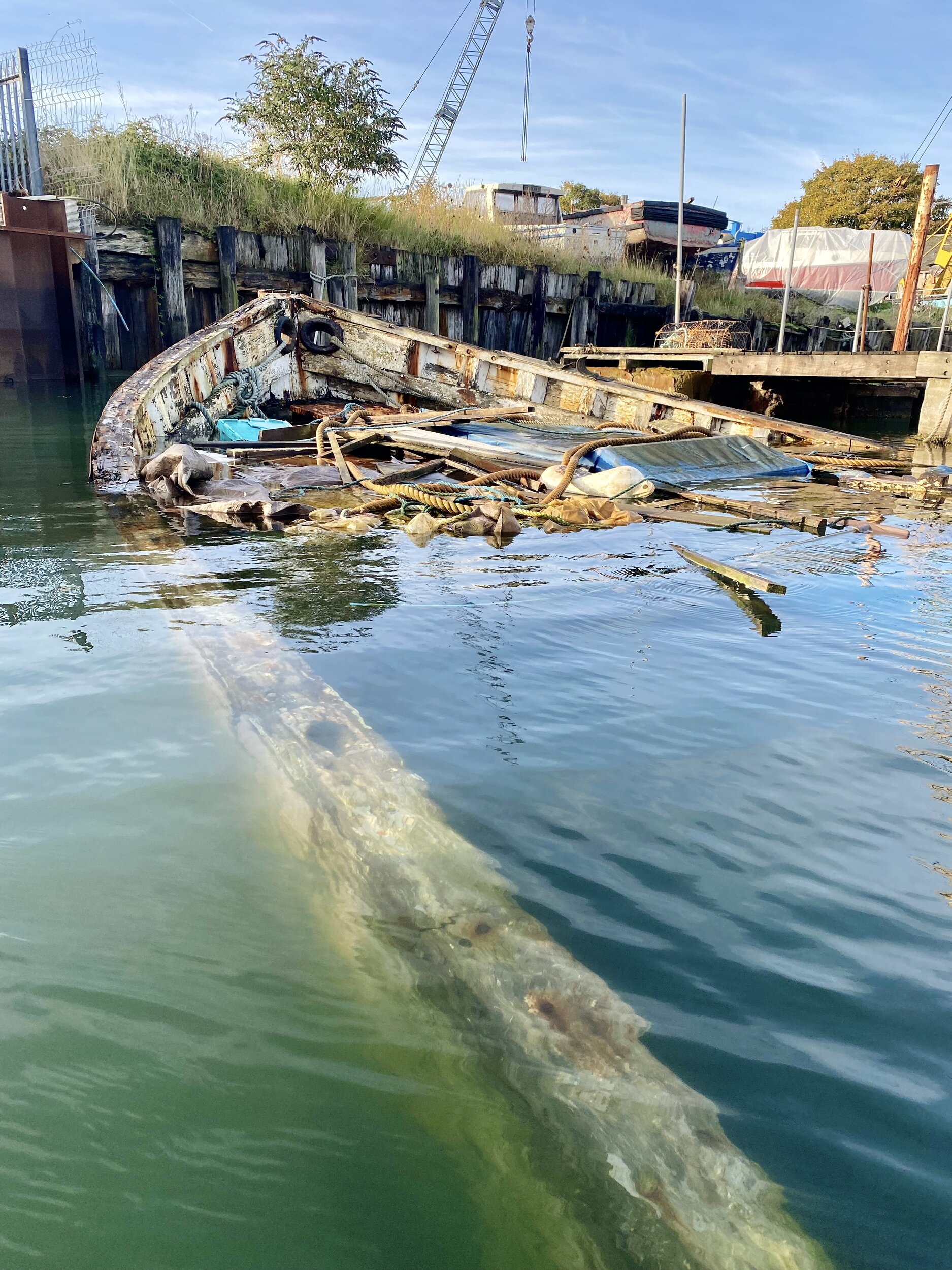

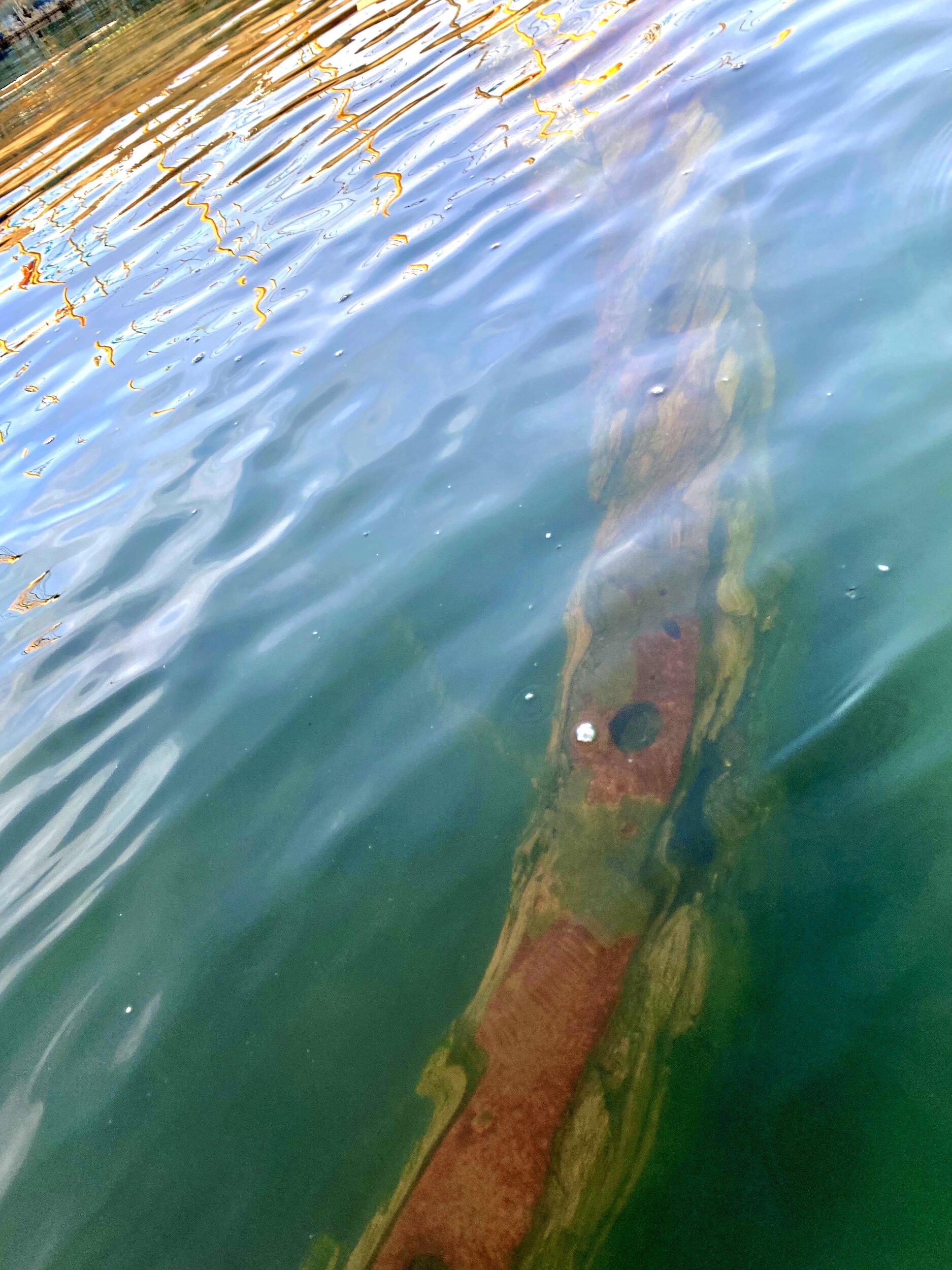
As a final bonus shipwreck, when paddling back to my car I noticed a modern radio mast in the distance at a strange angle (red circle on the satellite view above) so paddled over to take a look to find a modern fishing or survey vessel had sunk quite recently. I have no idea what this boat is or why it sank but it must have happened fairly recently as it stank of fuel and still had the floating oil bund up around it to prevent contamination. After taking a couple of photos I heading to shore, packed up the kayak and went to have some food.
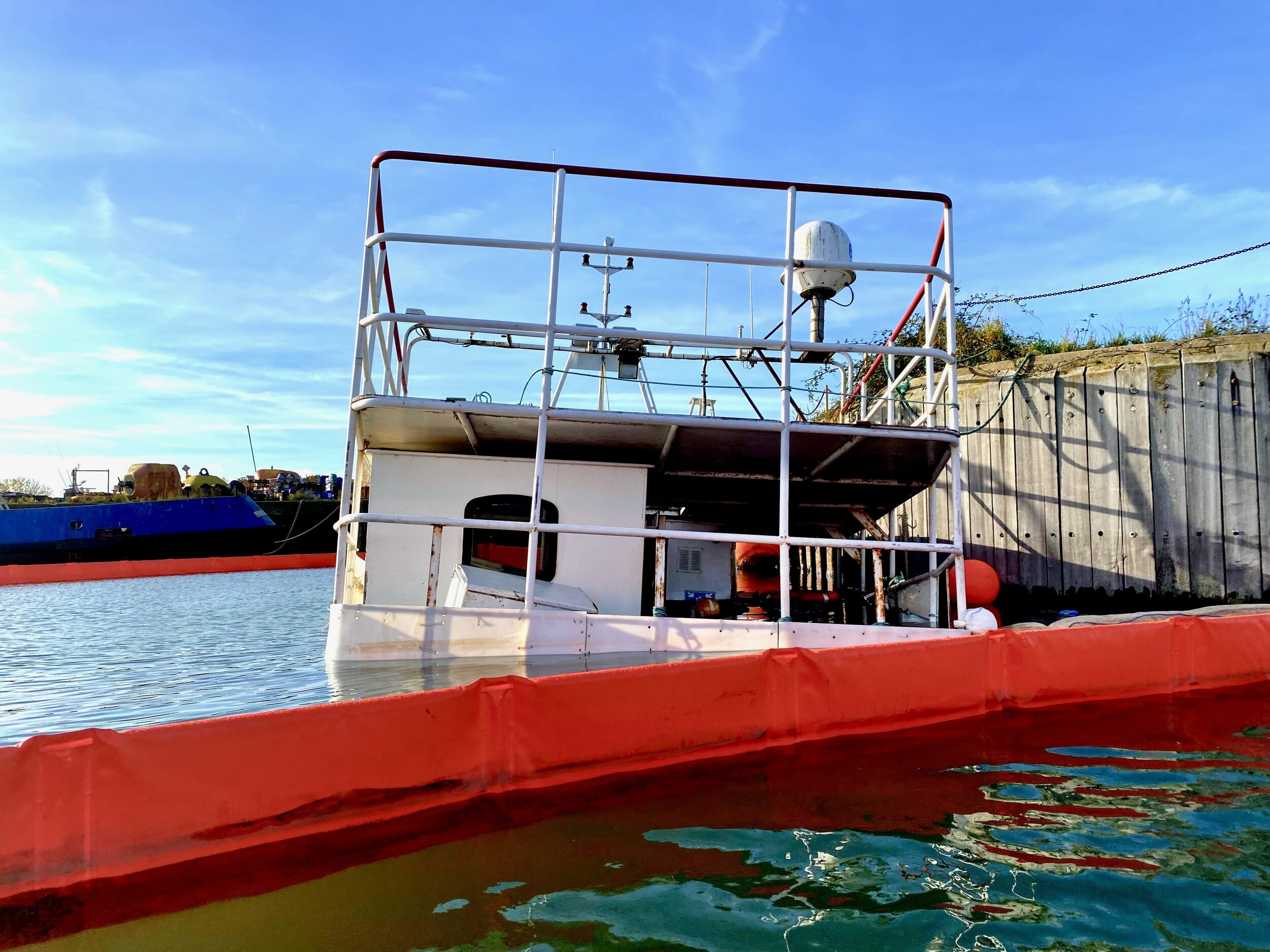
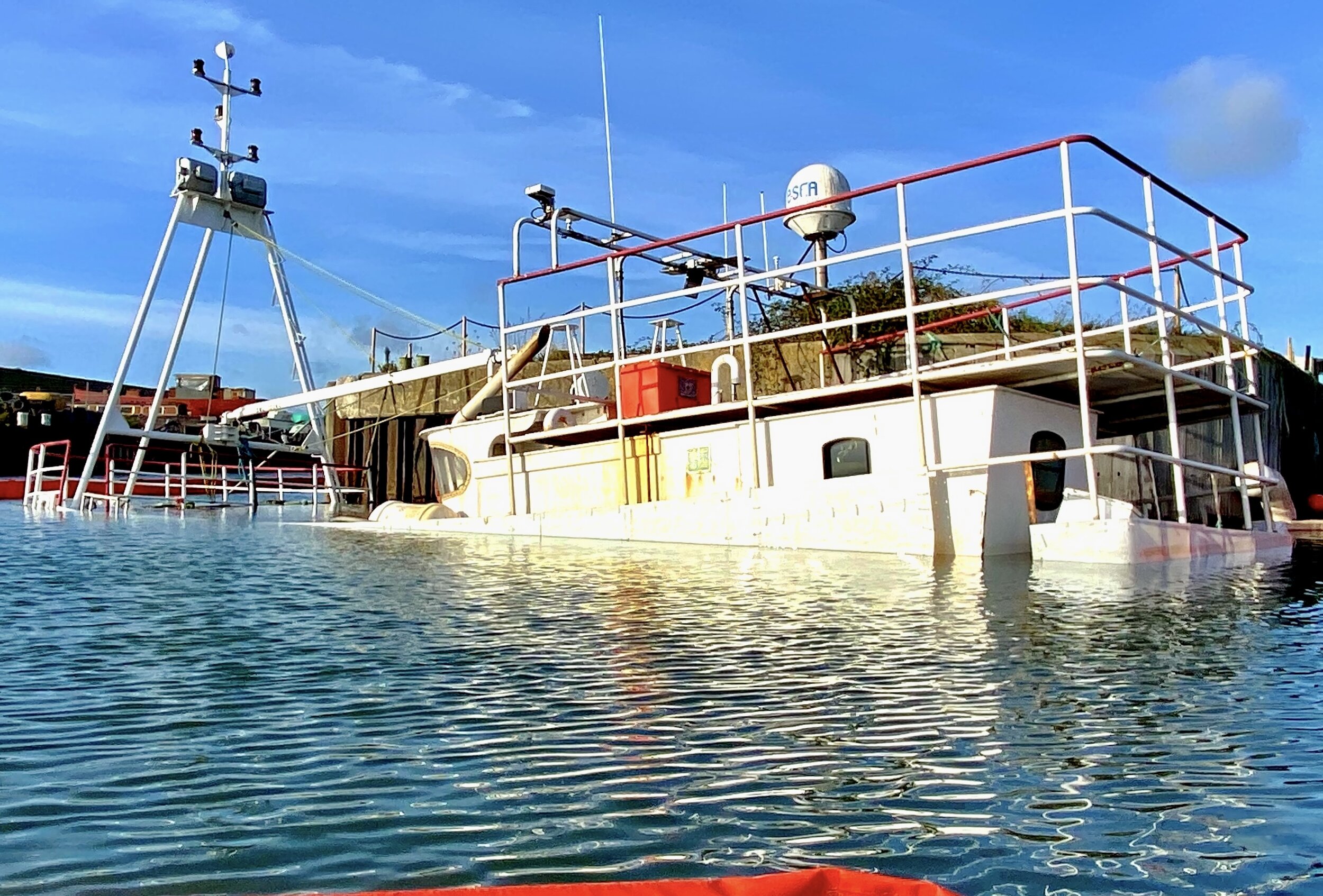
Once again, apologies for the length of this, hope it is of interest to some.
Lake Lothing is a tidal basin that forms part of the Port of Lowestoft and back in at the peak of the herring fishing era was filled with boats and shipyards. Since the decline of the fishing industry, most of the shipyards and fishing vessels around Lake Lothing have disappeared.
There are records of over 200 vessels of various kinds being hulked or beached on the shores of Lake Lothing, with many of these being broken up of scrapped in the shipyards or just left to rot. Over the last 30 years many of these having been broken up or have just rotted away into the mud.
There are now very few hulks left visible, however those that remain are very charming in their own way and uniquely interesting. In the satellite view below I have shown where some of these wrecks are.
I got up early one cold morning, went down with my inflatable packraft and launched into the lake from one of the derelict slipways. Unfortunately, I had had chosen a day with a very high spring tide so the wrecks were a bit more hidden than I would have liked.
The first ship I came across was the MV Probe (marked with a green circle above), an WW2 Admiralty Type Motor Minesweeper (MMS 1086) built in Lake Lothing between November 1942 and August 1944.
There were 90 of this type of MMS class minesweepers produced, nicknamed Mickey Mouses, they measured 38m long and 8m wide, with a displacement on 360 tonnes. They were made with wooden hulls so that they would not be vulnerable to magnetic mines used extensively by the German Navy and were fitted out with 4x20mm guns. Below is a picture of this vessel in all its glory in all its glory.
This vessel (MMS 1086) was transferred in 1944 to the Norwegian Navy and named Vefsna. After the war, she was sold to the Norwegian Government and outfitted as a hospital ship. In 1961 she was sold into private ownership and converted into a survey vessel for undertaking seismic surveys on the sea floor (called RV Probe) and operated out of Lowestoft searching for North Sea Oil and Gas reserves. Above right is a picture taken in the 1940s of her fitted out as a hospital ship.
In 1969 she was sold again to a scrapyard in Lowestoft, but the yard went bust before demolition could commence and the hull was left abandoned and unowned. Since then, she has sat there slowly rotting away. Below is the wreck in its current state from the stern first and the bow, with the ships name still visible in both, and then form the side with an inquisitive swan.
Below shows the state of the ship’s sides, rotting away and full of holes with large rusting nails sticking out.
Below shows the insides of the ship – first looking back towards where the wheelhouse once stood, with the decks collapsing, and the second photo looking forwards towards the radio mast and front deck.
Moving down the hull, being careful not to puncture the kayak on all the nails sticking out, the funnel and cabin can be seen in more detail. Both of these are sinking rapidly into the hull
The next wreck I came across was the LT326 Yellowtail, a 119-ton MFV (Motor Fishing Vessel) which was a class 1501 beam trawler built between December 1942 and September 1945 in Cornwall. (MFV 1529)
Originally ordered by the Admiralty, 81 Motor Fishing Vessels (MFVs) in the ‘1501-Class’ were built during World War II. MFVs were small wooden craft, 26m long by 7m wide, built-in large numbers during the war for use as Ship's tenders. They had a crew of 11 men, and standard armament of 1 20mm Anti-Aircraft gun for defence.
After the war, this ship operated out of Lowestoft as a fishing vessel named Maravanne until 1959 where its name was changed to Yellowtail. Whilst moored in Lake Lothing she sank in 1979 between the road and rail bridges (shown by the yellow triangle in the satellite image above). She remained here for a while (see below left prior to sinking and right after).
In late 80s she was raised and moved to the other side of the rail bridge where she has remained since. Over the years, the aft cabin, superstructure and deck have slowly collapsed leaving just the wheelhouse section standing proud above the deck. The photos below show the wreck from behind (left) and from floating above the deck (right).
The photos below (left) show the back of the funnel and wheelhouse, floating above the tangled remains of the aft cabin, and below right shows the funnel and wheelhouse with the rising sun coming up behind (making photos very tricky).
The photo below is a close up of the front of the wheelhouse.
The photos below are taken from just in front of the bow looking down both sides of the wreck.
Immediately next to the Yellowtail lies the LT205 RV Platessa, also a 1501 class (MFV 1576) built in 1944 in the same yard as the Probe above but completed around the end of the war, never seeing service. After the war she was operated by the Ministry of Agriculture, Fisheries and Food as a research vessel until 1967 conducting research on the herring and plaice population in the North Sea. Below is a picture of her in action.
Sold into private ownership in 1968, she sprung a leak near Smith’s Knoll off the north Norfolk coast and was escorted into Lowestoft harbour under escort of the Lifeboat. She sank in the dock shortly after and was eventually hulked out the way in Lake Lothing where she has remained since, next to the Yellowtail, her sister ship.
In the picture below left, the bow can be seen still sticking above the water, still with mooring ropes attached. The wreck of the Yellowtail can be seen to the left. In the bottom right photo I am floating on the main deck about where the cabin would have stood. The large hatch into the hold that can be seen is the same one in the black and white phot above on the foredeck, this is where the fish would have been loaded into.
The photo below is taken by the main deck hatch, at low tide the full deck is visible but at high tide (when it isdeep enough to paddle to) only a small amount is visible.
On the opposite side of the lake (see the purple circle above) lies the Eadwine (YH228) which was built in Great Yarmouth in 1914 as a steam drifter. During WW1 she was outfitted with a 6lb gun and served as an armed drifter for the duration of the war under the pennant FL11682. The picture below shows the Eadwine with a canon mounted on the foredeck (I don’t know if this is WW1 or WW2).
Between the wars she returned to herring fishing out of Great Yarmouth and during WW2 was again called into service (under the Penant FY1892), being outfitted with a 3lb gun and used for patrolling purposes throughout the war.
Interestingly, the Association of Dunkirk Little Ships lists the Eadwine as one for the little ships used during Operation Dynamo, the evacuation of Dunkirk.
After WW2 the Eadwine reverted to operating as a herring drifter (designated YH228) until the circa 1962 when it was sold to a breakers yard. Now only the skeletal remains of the bow, hull and the 26-horsepower steam engine are still visible above the water, as shown below at both low tide (below left) from the shore and at high tide from the water (below right). In the left phto, the stern and the engine can just be seen sticking up out of the mud.
Below is the remains of the 26 horsepower (yes, only 26 hp!!) steam engine. In the left photo the bow can be seen in the backgorund.
Whilst paddling around I also noticed a few other boats or barges that had suck (e.g. shown by the blue circle in the satellite view above and photos below). At one point I felt the kayak hit something solid, looked down and could see the vague outline of a bow lurking sinisterly beneath me.
As a final bonus shipwreck, when paddling back to my car I noticed a modern radio mast in the distance at a strange angle (red circle on the satellite view above) so paddled over to take a look to find a modern fishing or survey vessel had sunk quite recently. I have no idea what this boat is or why it sank but it must have happened fairly recently as it stank of fuel and still had the floating oil bund up around it to prevent contamination. After taking a couple of photos I heading to shore, packed up the kayak and went to have some food.
Once again, apologies for the length of this, hope it is of interest to some.



